1 Volumes
Rt. Angle by Years
The history of Philadelphia"s finest men's club.
Right Angle Club 2009
The 2009 proceedings of the Right Angle Club of Philadelphia, beginning with the farewell address of the outgoing president, John W. Nixon, and sadly concluding with memorials to two departed members, Fred Etherington and Harry Bishop.
GENTLEMEN: This time last year our country was facing a severe financial crisis. We had no idea who would be affected, or by how much. As the news darkened daily, the Friday Right Angle meetings continued to provide good cheer, solid friendships, and enlightening speakers. It was truly a bright spot on the calendar.
I was concerned that we would lose a few members who might be directly affected by the economic problems. I was also worried that the economy would hamper recruitment of new members. Fortunately, neither was the case. Instead, we have five new members: Jack Foltz, Bill Hill, Walter McClatchy, Robert St. George, and Bill Brady. Thanks to Jerry Leon who has been very active in recruiting. I hope that, as the economy picks up, we will continue to attract more good members. Joe Martinez has headed the Membership Committee for a number of years and I feel certain that he will continue this important campaign.
Unfortunately, Roger Hamm resigned due to pressures from his job. We wish him well. Rick Bongiovanni (Past President '99) asked to be put on the inactive membership roll. It seems it would be onerous for Rick to commute weekly from Italy, where he just bought a castle. (The good news is that Rick is willing to host next year's President's Dinner at his place!)
Sadly, two members of The Club passed away. Harry Bishop was a member for 7 years, a number of which were as an at-large Board member. Fred Etherington (Past President '58) was The Club Historian and Archivist Emeritus. Those that knew them will remember both with fondness. A separate tribute will follow for each of the gentlemen.
www.philadelphia-reflections.com/topic/123.htm No report to the Membership would be complete without recognizing the people that made our Club work this year:

Second, we have several members who should be specifically mentioned:
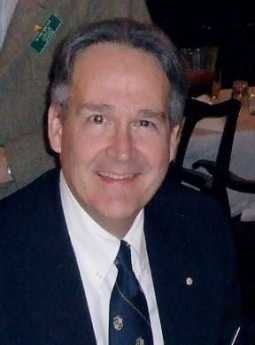
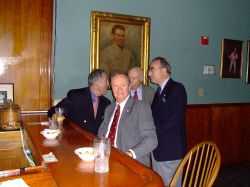 I asked Joe Martinez to fill the position of the 1st Vice-President. Joe has been an active Board member; has headed the Membership Committee; has been a member of the Nominating Committee; and has organized and published the Club Directory for the last 4 years. I wish Joe well as he moves into the President's position for 2010.
I asked Joe Martinez to fill the position of the 1st Vice-President. Joe has been an active Board member; has headed the Membership Committee; has been a member of the Nominating Committee; and has organized and published the Club Directory for the last 4 years. I wish Joe well as he moves into the President's position for 2010.
 Bob Reinecke, as 2nd Vice-President, opened 3 new venues for The Club luncheons. We had a great lunch and some operatic arias at Victor's. The Waterworks was the scene of our Fall luncheon. That was followed the next Friday by a speaker who gave us the history of The Waterworks. It was a good follow-up to a superb luncheon. Our Christmas luncheon at The City Tavern was the last of three great new restaurants that we experienced. We are always glad to explore new places to party!
Bob Reinecke, as 2nd Vice-President, opened 3 new venues for The Club luncheons. We had a great lunch and some operatic arias at Victor's. The Waterworks was the scene of our Fall luncheon. That was followed the next Friday by a speaker who gave us the history of The Waterworks. It was a good follow-up to a superb luncheon. Our Christmas luncheon at The City Tavern was the last of three great new restaurants that we experienced. We are always glad to explore new places to party!
 John White, our 3rd Vice-President, was the Speaker Chairman. That position is one of the most daunting of any on the Board. When you realize you have just agreed to arrange for forty or so speakers, all of whom should be interesting, and reliable -- the first thought is a panicky “I'll quit The Club.” John quickly learned, as all of us who have held that position learned, suggestions from the members supply most of the ideas for the speakers. Nevertheless, the scheduling and arranging for those speakers is a big job, and John did well. The speakers' various subjects are listed in this Annual Report. John also introduced The Club to the idea of a Socrates Café, which is a round table discussion of various ideas. I was glad that all behaved themselves, and no food was thrown. Thanks to John for adding a new dimension to our meetings.
John White, our 3rd Vice-President, was the Speaker Chairman. That position is one of the most daunting of any on the Board. When you realize you have just agreed to arrange for forty or so speakers, all of whom should be interesting, and reliable -- the first thought is a panicky “I'll quit The Club.” John quickly learned, as all of us who have held that position learned, suggestions from the members supply most of the ideas for the speakers. Nevertheless, the scheduling and arranging for those speakers is a big job, and John did well. The speakers' various subjects are listed in this Annual Report. John also introduced The Club to the idea of a Socrates Café, which is a round table discussion of various ideas. I was glad that all behaved themselves, and no food was thrown. Thanks to John for adding a new dimension to our meetings.
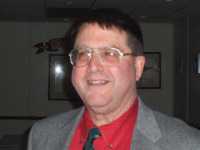
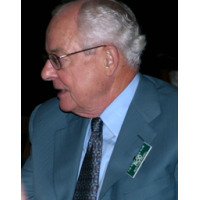 Rod Rothermel, our Treasurer, is a fine steward of our funds. All the Treasurer's reports are done, and presented, in longhand. No spreadsheets for Rod. I have a vision of Rod, wearing a green visor, running all the numbers on a Comptroller's machine. The only member that has been with the Club longer than Rod is Otis Erisman. Rod has an invaluable recollection of individuals, anecdotes, and past events. I am going to recommend that he accept the position of Club Historian.
Rod Rothermel, our Treasurer, is a fine steward of our funds. All the Treasurer's reports are done, and presented, in longhand. No spreadsheets for Rod. I have a vision of Rod, wearing a green visor, running all the numbers on a Comptroller's machine. The only member that has been with the Club longer than Rod is Otis Erisman. Rod has an invaluable recollection of individuals, anecdotes, and past events. I am going to recommend that he accept the position of Club Historian.
 Jack Hinckle has held the job of Corresponding Secretary for four years. That's forty-eight newsletters with something new, witty and fresh in each one. Thank you, Jack, for producing the timely, informative, and amusing missives that come our way each month.
Jack Hinckle has held the job of Corresponding Secretary for four years. That's forty-eight newsletters with something new, witty and fresh in each one. Thank you, Jack, for producing the timely, informative, and amusing missives that come our way each month.
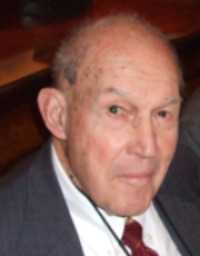 Recognition needs to be given to Bob Hinckle, (Past President - '95). He is still actively engraving new member name tags, and providing replacements for old members who lose theirs. He also does the “Coveted Right Angle Plaque” for the speakers -- forty of them a year, all on time and with names spelled correctly.
Recognition needs to be given to Bob Hinckle, (Past President - '95). He is still actively engraving new member name tags, and providing replacements for old members who lose theirs. He also does the “Coveted Right Angle Plaque” for the speakers -- forty of them a year, all on time and with names spelled correctly.
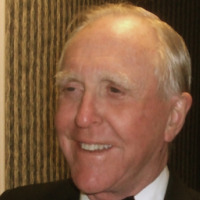 David Richards faithfully recorded the minutes of the Board meetings with absolute accuracy. Though, there were occasional questions from Alan Lawley as to why David didn't use proper English. Their repartee brought a lot of good humor….okay, Alan, humor to the meetings.
David Richards faithfully recorded the minutes of the Board meetings with absolute accuracy. Though, there were occasional questions from Alan Lawley as to why David didn't use proper English. Their repartee brought a lot of good humor….okay, Alan, humor to the meetings.
I enjoyed working with and getting input from the at-large members of the Board: Dan Sossaman, Alan Lawley, Mel Buckman, and John Fulton.
At one meeting, John Fulton was sitting at the far end of the Board table looking like a kid in class who didn't want to be called on. So I did. I asked John to look into options for a new charity for our year-end donation. He took the assignment with gusto. John did a fantastic job of looking into various charities and submitting reports on the top three. The Board asked him to look further into the Children's Scholarship Fund, Philadelphia. Based upon his final report, we voted to support it as our new charity.
I give a tip of my hat to Dave McCormick, our Archivist. The membership for years to come will appreciate the efforts of the men who have kept the records of The Club's activities.
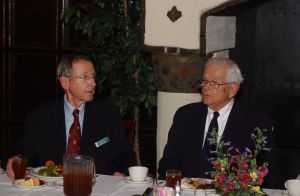 Thanks to and his band of Merry Men, Buck Scott and Peter Alois, who drew up the slate of the incoming Board. I believe it will be an active and successful group.
Thanks to and his band of Merry Men, Buck Scott and Peter Alois, who drew up the slate of the incoming Board. I believe it will be an active and successful group.
 Thanks to Dick Watson for his efforts in taking speaker notes for this directory whenever George Fisher was absent, and also for taking individual member pictures for the new Directory. I think that will make quite an improvement.
Thanks to Dick Watson for his efforts in taking speaker notes for this directory whenever George Fisher was absent, and also for taking individual member pictures for the new Directory. I think that will make quite an improvement.
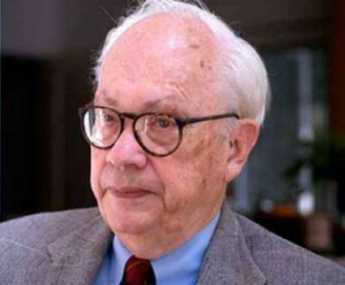 And, finally, I offer a hearty thank you to George Fisher for his unfaltering dedication to publishing our professional Annual Report, which includes his research and recap on the year's Speakers. It is always enlightening and represents untold hours of effort…..and The Club has yet to see a bill for this important yearly record. George has underwritten the whole project.
And, finally, I offer a hearty thank you to George Fisher for his unfaltering dedication to publishing our professional Annual Report, which includes his research and recap on the year's Speakers. It is always enlightening and represents untold hours of effort…..and The Club has yet to see a bill for this important yearly record. George has underwritten the whole project.
I now pass the Gavel on to Joe Martinez, your new President for 2010. I hope his tenure will be as fulfilling as mine was for me.
-- Jack Nixon
Touring Bhutan

|
| Bhutan |
Neale Bringhurst, 2008 President of the Right Angle Club, just returned from a two-week revisit of a remote place he hasn't seen in 17 years, and told the club all about it, with slides. Neale warns prospective tourists that twelve time zones separate Bhutan from Philadelphia; if you fly over for two weeks and then fly back, you get 24 days of jet lag, since jet lag recovery takes about one day per one hour time difference. Seventeen years ago, the tourists were all backpackers, but now there are a noticeable number of senior citizens. Going up and down 14,000-foot mountains more or less continuously tends to give younger climbers bad headaches, older ones breathing difficulties if they don't take pills. And perhaps sometimes if they do. The highest mountain (Mount Chomolhari) is 24,000 feet tall, offering a daunting experience for adventurers.

|
| King Jigme Khesar Namgyel Wangchuck |
While the life expectancy of Bhutanese is 66, the median age is 19.4, thus implying a lot of children and lots of accidents. The country now seems considerably more modern than one would expect for a remote mountainous region, compared with Nepal for example, and compared with seventeen years ago. There are plenty of colorful temples and monuments, street markets, and native costumes, but things change fast so you better hurry if you value local color. Buddhism is a very friendly religion, and the children delight in posing for pictures. The king is 28 years old, an Oxford graduate, fourth of his family dynasty established in 1907. The government is tripartite: divided between the monk body (Je Kempo), the National Assembly (which can remove the king), and the Wangchuck monarchy. The population at 65,000 is only twice as large as Philadelphia's own mountain region of Radnor Township, and mostly agricultural, but English is almost as common as the Mongol heritage. They don't look or act like either Chinese or Indians. A foreigner uneasily wonders what it means that a sizable proportion are named Wangchuck.
A third of the national income is provided by tourism, and another large part comes from the sale of hydroelectric power to India, so this largely agricultural country is not as cash poor as is often the case. The national diet largely consists of rice and potatoes, and prospective tourists must be warned that rancid butter tea is quite popular. In Mongolia, the corresponding beverage is fermented mare's milk, so perhaps there's something ethnic going on.

|
| Takin |
Visitors are unlikely to see snow leopards, but magpies, eagles and vultures are abundant, as are yaks and a strange-looking National animal called a Takin. Takin looks like a fat short-legged moose without antlers. The native language can prove difficult; the word "LA" means at least three different things: mountain pass, kind of soul, and a polite term for ending a sentence. In case wise-apple tourists have any doubt, the monks are in charge, and will call the cops if you sit on their favorite rock.
In many ways, the most interesting and illuminating topic about the whole nation is a concept called Gross National Happiness (GNP), about which more will be said in another place.
Gross National Happiness In Bhutan

|
| Gross National Happiness |
When feudal and primitive cultures come in contact with more advanced ones, their response is apt to be to reject modernism in all its forms and trappings. The Pennsylvania Amish, the American Indian, and most Middle-Eastern countries display this response. After a while, the advanced countries just give up appealing to them, and resort to extermination, with results that are very sad. The Kingdom of Bhutan has a 28 year-old king who went to Oxford, a long-rejected Mongolian Genghis Khan heritage, and a reflective self-denying Buddhist religion. Twenty-five Stanford professors who every year come and study the place may possibly contribute something to locally prevailing ideas as much as they learn from them. In any event, the charming Bhutan response of Karma Galay (Gross National Happiness) ought to be deeply thought-provoking.
Unlike so many other countries in this position, Bhutan does not resist progress but fully anticipates it. They also anticipate the disorder which will result when their young people watch satellite television and want to have some of those consumer durables for themselves. Buddhist culture teaches you to keep your life simple, and the root of all observable evil is -- craving. What's obviously more important is to be happy, so why not measure happiness in some Western way and see how you are collectively doing. From this comes the idea that since economic strivers and cravers measure their economic progress by Gross National Product, why not apply a statistical approach to what Buddhists truly want, which is happiness, and see how they are making out?
That includes a broad methodology. Buddhist teaching emphasizes never harming any sentient creature, but rather devoting constant attention to removing impediments to happiness from themselves and others. A country dead-set against consumerism recognizes that Internet and TV are going to assault them with consumerism, and they want to preserve an open mind about whether it is improving happiness or injuring it. Most American parents would agree that a case can be made in both directions, so let's be fair, let's measure it. No doubt many of the monks harbor a suspicion that happiness will lose, and proven deterioration in GNH can be used to show why they should close their borders and hunker down. Others, probably including those Stanford professors, probably anticipate that a demonstrated rise in GNH can be used to pacify the conservatives whenever the facts show the whole country is happier if they substitute something else for rancid butter tea, rice and potatoes. On a less grandiose level, perhaps different strategies of education can be tested as Bhutan goes from the Fifteenth Century to the Twenty-first, relieving stress when it appears, and augmenting community contentment if something probably has that result.
Maybe all Americans should give some thought to what is being said, here. Maybe in a strange way that's what Castro was failing to do in Cuba, and Cuba could now become an experimental laboratory for GNH measurement. Or Iraq or Russia. And of course, let's measure the consequences of our own cravings for achievement. Is, or is not, most of this self-denial just a lot of sour grapes? Let's give some thought to this, because if Thou shouldst mark iniquity, Oh Lord, who shall stand?
Field Marshal William Joseph Slim, 1st Viscount, Order of the Garter
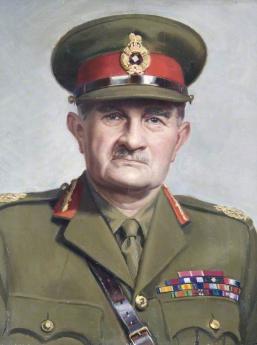
|
| Field Marshall William Joseph Slim |
It's impossible to be accurate about such rankings, but it must mean something when Field Marshall William Slim is the only officer of World War II to be ranked among the ten greatest generals of all time. The historian Ray Callahan recently described Slim's career to the Right Angle Club, with particular emphasis on how unlikely it was for a man of his humble beginnings even to be a Lieutenant in the British Army before World War I, how he endured pretty insufferable snubs along the way up the ladder of command, and how at the end of his career to be Chief of Staff he finally revealed that he had noticed those snubs, all right. Americans would be astonished at such class distinctions in their own army, and even raise the question how the British Army could possibly conquer the world for two hundred years with so little emphasis on merit selection of its generals.
First, the military story of Bill Slim. Before World War I, officer candidates were expected to pay for their own training, and he managed to get through a local college Officer Training course without enrolling in the college. Even that much training suddenly was in very short supply as Britain mobilized for the War, and he was commissioned with the limitation of "hostilities only" to emphasize that he was not in the "regular" Army. Working through the Mesopotamian campaign, he rose through the Indian Army, which Winston Churchill regarded as definitely second tier, with his permanent rank always lagging several levels below his "temporary", acting, rank. At one point, he received an official rebuke for advocating air power for ground support, since that was the turf of the Air Force, and on another occasion for irritating the Navy by using boats. When World War II suddenly sent Japanese forces plunging through Malaysia and Indo-China, Slim distinguished himself by keeping the defeated Indian Army intact through a 900 mile retreat into Burma, justifying his later memoir of turning Defeat Into Victory. During that demoralizing time, he had ample opportunity to observe the repeated Japanese tactic of launching lightning attacks without an established supply line, intending to live on the abandoned supplies of enemies as they were outflanked or surrounded by rapid advances. Slim developed the idea that if he's surrounded troops could be resupplied by air and hold out, the attacking Japanese would essentially starve to death in the jungle. One attacking Japanese army unit of 87,000 men was reduced to 13,000 survivors by the application of this strategy, and as long as the Japanese kept using their technique, Slim kept using his. One reverse variant of this use of air supply was employed by Slim in the recapture of Rangoon by himself attacking from the rear without the usual overland supply line, but resupplying by air as an approaching monsoon cut off the expected resupply by sea. After the war was over, Winston Churchill's history of the war's events contained only the briefest mention of these victories. When Slim finally met Churchill, a close election was taking place, and Churchill said he hoped the overseas ballots were cast for him. "Well, Prime Minister, I must say that no officer in my command voted for you," was the reply he got. When Churchill's successor Clement Attlee was told by Bernie Montgomery that the Chief of Staff position was promised to someone else, the terse order was, "Well, unpromise him." And Slim got the job.
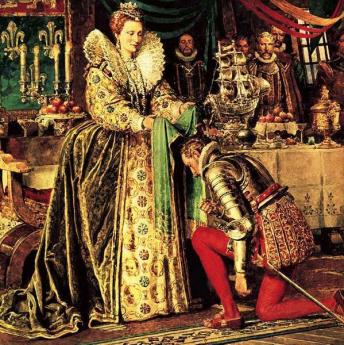
|
| Sir Francis Drake kneeling to Queen Elizabeth |
So, Ray Callahan the historian was asked the typically American question of however could the British Empire conquer Napoleon or plant the British flag over most of the world, using a system that would deliberately hold back an officer of Slim's talents, snubbing and intentionally humiliating most of the nation whenever one of the lesser orders was cheeky enough to aspire to military leadership. With great patience, Callahan replied that this system of placing aristocrats in charge of the military was designed to maintain civilian control against the military uprising. There might have been a time when King Arthur or King Henry V was personally in charge of the Army, but King Macbeth and General Cromwell both illustrate the disadvantages of a fully feudal system. Even before the Industrial Revolution, military skill did not translate well into the skills needed to run an industrialized country but nevertheless provided an easy route for a power-hungry military to seize the crown. It is true that America tends to elect prominent generals to be president after each of our major wars (Washington, Jackson, Harrison, Grant, and Eisenhower) and indeed most other presidents have had some military experience. But ever since George Washington made the principle clear, there has been a prevailing imperative about maintaining civilian control of the serving military, which even the American military seem to agree with. So it is not surprising that other nations with some more bitter experiences to recall insist on more than social pressure to maintain civilian control. Inherited wealth not only provides genetic advantages and a de-glamorized experience with power, but it tends to create its own local environment which regards power as scarcely worth striving for, power is what you have, not what you strive for, there's not a great deal to gain from overturning things. While not inordinately brilliant, hereditary aristocrats are not inordinately stupid, either; they produce their share of Wellingtons, Patton and Macarthurs.
In the first World War, however, the British discovered a serious flaw in the aristocratic system. Most defenders of that system will stress the high morale developed within the comradeship of a 1000-man regiment, carefully selected to choose individuals who "fit in". The British Army has been described as a "loose federation of regiments", collecting the history and traditions of the British Army in a way best understood in America by noting the special fervor of the U.S. Marine Corps. There is an undeniable disadvantage, however. In a mass mobilization, following a selective mass slaughter of volunteers (90% of British Regular Army officers were casualties in World War I), there simply may not be sufficient numbers in the historic regiments to run an effective mass army. That is the implied recognition behind the creation of officers for the duration of hostilities, only; get rid of that sort when the war is over because they can become a threat to cohesiveness. Some of that concern surely runs through the steady drumbeat to take guns away from the public, Second Amendment notwithstanding, repeal that damned thing if you have to. And the converse runs through the thinking of the Second Amendment supporters; you never know when some power freak might seize control of the military. The southern half of the country leans more strongly in that direction. They remember the experience of Reconstruction when official reins of power were in hostile hands. The Old South really likes the idea of its sons running all branches of the military at all levels. Makes a fellow more comfortable with having a strong government.
Philadelphia City-County Consolidation of 1854
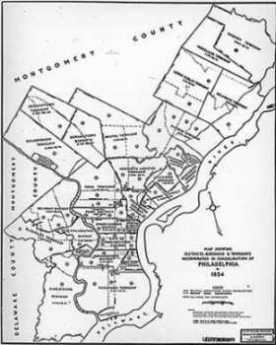
|
| Consolidation Map 1854 |
Philadelphia is still referred to as a city of neighborhoods. Prior to 1854, most of those neighborhoods were towns, boroughs, and townships, until the Act of City-County Consolidation merged them all into a countywide city. It was a time of tumultuous growth, with the city population growing from 120,000 to over 500,000 between the 1850 and 1860 census. There can be little doubt that disorderly growth was disruptive for both local loyalties and the ability of the small jurisdictions to cope with their problems, making consolidation politically much more achievable. A century later, there were still two hundred farms left in the county which was otherwise completely urbanized and industrialized. For seventy-five years, Philadelphia had the only major urban Republican political machine. By 1900 (and by using some carefully chosen definitions) it was possible to claim that Philadelphia was the richest city in the world, although this dizzy growth came to an abrupt end with the 1929 stock market crash, and the population of Philadelphia now shrinks every year. In answering the question of whether consolidation with the suburbs was a good thing or a bad thing, it was clearly a good thing. But since Philadelphia is suffering from decline, it becomes legitimate to ask whether its political boundaries might now be too large.
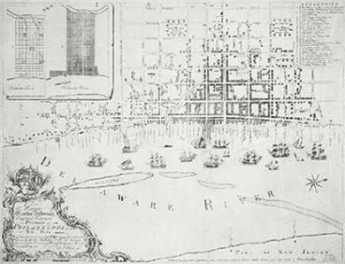
|
| Philadelphia Map 1762 |
The possible legitimacy of this suggestion is easily demonstrated by a train trip from New York to Washington. The borders of the city on both the north and the south are quickly noticed out the train window, as the place where prosperity ends and slums abruptly begin. In 1854 it was just the other way around, just as is still the case in many European cities like Paris and Madrid. But as the train gets closer to the station in the center of the city, it can also be noticed that the slums of the decaying city do not spread out from a rotten core. Center City reappears as a shining city on a hill, surrounded by a wide band of decay. The dynamic thrusting city once grew out to its political border, and then when population shrank, left a wide ring of abandonment. It had outgrown its blood supply. Prohibitively high gasoline taxes in Europe inhibit the American phenomenon of commuter suburbs. The economic advantage of cheap land overcomes the cost of building high-rise apartments upward, but there is some level of gasoline taxation which overcomes that advantage. Without meaning to impute duplicitous motives to anyone, it really is another legitimate question whether some current "green" environmental concerns might have some urban-suburban real estate competition mixed with concern about global warming. Let's skip hurriedly past that inflammatory observation, however, because the thought before us is not whether to manipulate gas taxes, but whether it might be useful to help post-industrial cities by contracting their political borders.
Before reaching that conclusion, however, it seems worthwhile to clarify the post-industrial concept. America certainly does have a rust belt of dying cities once centered on "heavy" industry which has now largely migrated abroad to underdeveloped nations. But while it is true that our national balance of trade shows weakness trying to export as much as we import, it is not true at all that we manufacture less than we once did. Rather, manufacturing productivity has increased so substantially that we actually manufacture more goods, but we do it with less manpower and less pollution, too. The productivity revolution is even more advanced in agriculture, which once was the main activity of everyone, but now employs less than 2% of the working population. This is not a quibble or a digression; it is mentioned in order to forestall any idea that cities would resume outward physical growth if only we could manipulate tariffs or monetary exchange rates or elect more protectionist politicians to Congress. Projecting demographics and economics into the far future, the physical diameters of most American cities are unlikely to widen, more likely to shrink. If other cities repeat the Philadelphia pattern, the vacant land for easy exploitation lies in the ruined band of property within the present political boundaries of cities, or if you please, between the prosperous urban center and the prosperous suburban ring.
Many American cities with populations of about 500,000 do need more room to grow, so let them do it just as Philadelphia did a century ago, by annexing suburbs. But there are other cities which have lost at least 500,000 population and thus have available low-cost low-tax land which would mostly enhance the neighborhood if existing structures were leveled to the ground. Curiously, both the shrunken urban core and the bumptious thriving suburbs could compete better for redeveloping this urban desert if the obstacles, mostly political and emotional, of the political boundary, could be more easily modified. But that's also just a political problem, and not necessarily an unsolvable one.
Cira Centre II - (?)
Everyone driving the Schuylkill Expressway in Philadelphia is familiar with the Cira Centre I (built 2005) because of its striking appearance both from the architectural standpoint and the display of moving lights at night. Situated right across the river from boathouse row it complements the area quite well. The Brandywine Trust company is working on plans to develop the area on the other side of the 30th street station into an office complex, one of the buildings - Cira Centre II - being quite similar in looks to the original. The area offers great potential for office and retail because it not only is in the center of transportation in Philadelphia but is also midway on the Northeast Corridor string of cities from Boston to Washington, D.C.
Building a multi-use complex like this in the center of a city is not without community commotion. The musical chairs go as follows: the post office distribution center moves to the vicinity of the airport; the IRS moves from its present location on Roosevelt Blvd. to the post office building; and the abandoned Roosevelt Blvd. the building will then most likely end up as a retail center. Retail business and office construction are at the mercy of stock market gyrations: although building costs are going down, financing is hard to obtain. Prospective tenants are relatively abundant. Brandywine hopes to obtain a single tenant to fill one 30 story mixed-use tower with a 15 story hotel next door. The attraction for both is not only the location but ready access to trains and expressway access plus subways, buses, and the downtown center on one side and the University of Pennsylvania on the other. The U. of PA is acquiring the underlying real estate ownership with a complicated system of leases to the prospective tenants. They also expect to place a number of athletic fields in the former parking area. Presumably, the recent decline in the stock market has somewhat cooled the ardor of the University endowment managers.

|
| New LED's at Boathouse Row |
Everyone has commented on the illumination of Cira I, which like the boathouse row, is lit by series of light-emitting diodes (LEDs) run by a single laptop computer. Cira II is contemplated to have a similar arrangement as well as a "green" roof covered with sedum and a plan for making the roof into a public park; we shall have to wait and see when the funding gets straightened out. More mundane considerations relate to drilling 35' to hit bedrock, for the pilings necessary, and to work around the Amtrak arrangements which accommodates 1000 trains a day. In the long run, however, the level achieved by the Dow Jones Industrial Average will surely have more influence on the decisions than the architects have.
Phillycarshare
 |
| Jerry Furgione |
Jerry Furgione recently intrigued the Right Angle Club with what those small red cars are all about. A non-profit organization named PhillyCarShare has been able to grow a fleet of 400 autos to rent by the hour -- gas, insurance and washing included. Each car has a home base in some parking lot or garage or other accessible place, from which you take it, and back to which it goes when you are done with it. Reservations are handled by phone or internet, payment by credit card; a platoon of attendants come around at night to refill the gas and check on things.

|
| Philly Car Share Lot |
Now that's not quite as convenient as having the car delivered, or picking it up at one place and dropping it off at another, but it's workable. One of the technical secrets is a wireless system working a lock which can be controlled remotely. For a $25 onetime membership fee the customer gets identified with a particular lock, and the car keys are inside the car. That's a little kludgey (as trendy people say) because if you forget to lock the car when it's parked it can be stolen. No doubt technology could soon be developed to handle the whole business electronically, emitting signals that the car is parked but unlocked, issuing automated scolding and just-this-once remote locking and unlocking, and perhaps a dozen other engineering features. But that requires more volume than 400 cars, and it's early days. Present reliance is made on repeated reminders to lock the car when you aren't using it, backed up with a $100 fine if you forget. It's probably the biggest source of friction.
The rise in oil prices helped the car share business a lot, and enthusiasm among young early-adopters carries things quite a way, so the business is growing. It probably won't be possible to judge the future until competition appears and business levels off, at some stable point. If some of the rough spots can be fixed with gadgetry, this hourly rental system should have a permanent place in our environment. Since it's a non-profit, it will be of interest to see what variants the for-profit sector can provide.

|
| City of Philadelphia |
At the moment, the business has the nuisance of an average 6-months delay to get each new parking spot approved by the various ownership and licensing agencies. But the developers of high-rise apartments are learning that having rental cars headquartered at the building entitles the builder to provide fewer off-street parking spaces, so revenue potential starts to appear. Companies, and in particular the City of Philadelphia have taken to using this system to reduce the size of their car fleets; universities are nibbling at the idea of shared memberships. Hard to know where this will lead.
You learn some things the hard way. The cars once had a plastic card to use for filling up at a gas station, but too many cars were broken into to steal the cards, so this had to be curtailed. If you have an accident the company's insurance takes care of you, but then there are quarrels about renewals of insurance, both theirs and yours. People who are used to jumping into their own cars, and out of them whenever and where ever they please, tend to feel a little constrained by the need to make reservations and be prompt about them (because someone else might be waiting for the car).
Which brings you to the ultimate trade-off in this system. People want to have lots of cars sitting around, so they can use spur-of-the-moment planning. The business, on the other hand, wants every car to be in constant motion, every slot in the schedule filled up. Right now the cars average eight users a day and have comparatively little waiting for reservations, only because the typical user at present does not want the car during 9-5, five days a week hours. As business increases, it should emerge just what the break-even points are between too many cars and too few. From the customers' point of view, that means, "How much are you willing to pay to have a car immediately and invariably available?" At the equilibrium point between maximum customer convenience and minimum price, we'll soon see what the public really wants and will pay for.
Meanwhile, the experimentation goes on to explore the tastes and preference of the Philadelphia public, region by region. They have a few pickup trucks if you like, and even a few Lexus's. Although the original idea was developed in Europe, Philadelphia has here the largest hourly rental business in the world, and it's galloping along briskly.
Philadelphia City Controller
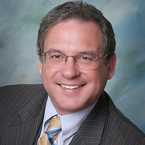
|
| Alan Butkovitz |
The Right Angle club was pleased to hear the City Controller, Alan Butkovitz, give us an insider's view of the municipal finances, but was a little startled to hear how badly the national banking crisis has affected our city. While of course the city does a lot of things, its present finances can be summarized as mainly consisting of two things: the pension system and the management of police/fire/corrections.
Mayors of this city for several decades have been following the national pattern of government to transfer its deficits to the pension funds of the employees. That has the effect of shifting the cost of present operations into the far future and avoiding present confrontations by promising even more generous pension benefits in the future. Over time, the future gets closer and closer; to a large degree, it is right now. Pension funds are largely independent organizations, supposedly receiving current contributions to be invested for future distribution. That requires an assumption about how much investment growth will be achieved in the meantime, now set by the Philadelphia Board of Pensions at 9%. That's not impossible to achieve in some medium-term intervals. But it's optimistic, even inconceivable, for long-haul investing; over periods of thirty or more years, most experts say that 4% is about all anyone gets. More to the point, 9% is particularly unachievable right now, in the present crash of national financial markets. That's bad enough, but repeated shortfalls in contributions to the fund have left it funded at 53% of the calculated requirement to pay the pensions of the future, even using the unrealistic 9% return assumption. A few years ago, Mayor Rendell worried about the underfunding and brought it up to 70% with a billion-dollar bond issue. Unfortunately, the crash in the markets has brought it right back down to 53% again. So, it's fair to say the pension fund is a couple of billion dollars short, even if you accept a 9% income accumulation -- which you probably can't, but at least it brings the pension fund to 70% funding in forty years. Call it four billion dollars short, just to be conservative, since it is presently admitted to being two billion. That isn't Mayor Nutter's fault, but it's sure his problem; and if it gets worse, it will be seen as his fault.
The other expense item of note includes 42% of the budget in the police, fire and prisons systems (education is handled separately through the school board). If you fired all those people, or they quit, we wouldn't have a city, we would have a jungle. But the Controller describes all three as terribly mismanaged, with the local police stations in a deplorable state of disrepair and degradation, bathrooms you wouldn't think of using, and so on. The fire department has only a minor number of fires to fight, perhaps four or five hundred a year, but it includes the emergency rescue services which respond to a couple hundred thousand calls a year. The rescue people report to the firemen, and there is social friction between the two, working to the disadvantage of rescue. It costs about $500 to respond to a call, and it isn't entirely satisfactory to send a fire truck to help someone with a heart attack. The Controller had a number of horror stories about administrative mismanagement in this area. As far as prisons go, everybody knows prisons are bad places, and ours are no exception. Confrontation with the unions is definitely in the future for the Mayor, and the city is going to be in pretty bad shape if he doesn't win some arguments.
That's the expense side of the municipal budget; the revenue side is equally gloomy. The offhand comment was that real estate taxes could double without bringing the pension system under control for twenty years. If our taxes are significantly higher than neighboring cities, or even just the same as in cities with superior uniformed services, it will be hard to attract and hold business taxpayers, causing municipal finance to spiral downward. Along the course of this patter-song, it isn't exactly reassuring to learn that it now takes the City 21 days to process a check and that absenteeism in some departments runs to 20%. We've heard a lot of denunciation of Mayors Giuliani and Bloomberg in New York, but their absenteeism runs 3% because investigators are sent to the house of an absentee, who is subject to court martial if he isn't home.
Somewhere in this nightmare lurks the hidden migration of the unionized workers. Starting with Mayor Rizzo or even earlier, the uniformed services were the main political support of the Democrat political machine. Quietly, they have moved out to the suburbs where the schools are better and the taxes are lower, and it is now said that 70% of union workers live (and vote) outside the city limits. The unions talk tough, bluffing through the uncertainty when their members can no longer provide the votes to be so fearsome. To some degree, their weakening political power is augmented by using their pension funds to provide construction loans for new commercial real estate. Some of that political clout is used up by the need to get zoning variances and tax abatements for the projects. A lot of these power shifts are hard to assess from the outside, but a trend is clear.
The controller didn't mention it, but the city is not only a pension investor in bonds but also an issue. Interest rates are about as low as they can get while the Federal funds rate is nearly zero, so there is only one direction they can go in the future -- sooner or later they will go up. By the iron law of bond financing, the value of the underlying principle will then go down. That could provide an opportunity to buy them back at lower prices, or it could break the city's financial back financing higher interest payments. However, for the pension fund side of things, exactly the opposite is true. Maybe Hizzoner can tap-dance around these dangers and opportunities, but most mayors would have trouble pronouncing the words.
It's part of the job description for the controller to be a pessimist. But the most you can make of this mournful dirge is to hope he is completely wrong.
Second Opinion: Dick Watson

|
| Alan Butkovitz |
It's not enough that Philadelphia City Controller, Alan Butkovitz, has to worry about the Dow Jones carrying the city's money away faster than it can be brought in, he also has to face years of inefficiencies in every major department that offer daily challenges even in the best of times. Add to this a city pension fund whose list of payees continues to grow at an ever-increasing rate while the funding which has been as high as 72% is now at close to 50%. Over the past four years, the deficit has doubled each year from $450 million to its present $2 billion.
Income from real estate has always been one of the major sources of income for the city but with new construction dramatically down along with sales of existing structures also having taken a nosedive, the challenges to keep the city's head above water grow daily. Add to this the fact of inefficient business practices, taking as long as three weeks to deposit checks for example, and one begins to see that there are many opportunities for improvement even with the bad economy. The loss of interest income from the late deposits alone runs into the millions each year.
Among major cities Philadelphia doesn't have a great graduation rate from either high school or college but what we do have is a vast workforce ready and able to work. Our port was once one of the busiest on the east coast and the infrastructure is there along with the muscle to make it work. With other ports in the country facing shortages of workers and facilities, this could be one of the prime initiatives to raise city income in the face of the declining real estate market and the work must be done to once again become a major player.
All of the money problems don't simply affect the various agencies in the city at the payroll level, the problems are much more pernicious than that: the very ability to do their jobs is at stake. Take, for instance, the rescue agencies reached through 911. There is insufficient equipment - both quantity and quality - as well as inefficient procedures which result in an ambulance taking as long as 40 minutes to arrive with help for a heart attack victim or even worse, not having the crew or equipment necessary at all which might result in sending a fire truck instead, which has neither the trained crew nor the ability to transport a patient. Mr. Butkovitz is dealing with these problems on a daily basis, studying solutions other cities have come up with and making headway in many areas but there is clearly much to be done.
Taking Care of Our Veterans
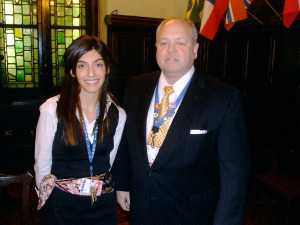
|
| Alexandra Esposito and Stephen Bennett |
The Civil War was barely over before Abraham Lincoln instituted programs designed to aid those wounded soldiers returning home from battle. Over the years such aid was expanded as both the needs and treatment expertise increased and in 1930 the Department of Veteran's Affairs was officially established. President Clinton elevated the department to cabinet level in 1996 and today there is virtually nothing that cannot be handled. Stephen Bennett and Alex Esposito described what is being done for our vets here in Philadelphia and throughout the country.
It's not too difficult to imagine how the horrors of war can affect our soldiers in both body and mind in ways that could not be imagined back in the 1860s when Lincoln first recognized our duty to those who put their lives on the line for us. Today, with such sophisticated ways of destroying life, the challenges call for specialized programs and the department seems to be doing a reasonable job at keeping up with destructive devices. Nothing bad ever seems to go away, we just find new types of injuries all the time to add to the list. For instance, we're seeing many cases of head injury caused by percussive types of weapons which cause severe brain damage while affecting only slightly the outer layers, like the skull and scalp. Special groups and operations have been formed within the department all along the way, the latest dealing with the special needs of the Iraq and Afghanistan troops.
The Philadelphia main office of the Veteran's Administration for Health is located at 39th and Woodland, right next to the University of Pennsylvania which it works closely with. Satellite offices such as those in Fort Dix, Coatesville and Gloucester, NJ, provide convenient locations for treatment of those not close to town. With a staff of over 2000 doctors, nurses and social workers and a budget of $330 million the area handles well-over 400,000 client visits each year. The Philadelphia unit is at the forefront of using the latest in electronic storage and retrieval systems to access records wherever they might be and has received awards for their expertise. The hospitalization facilities have improved steadily and the open bay wards are a thing of the past as are the archaic and makeshift diagnostic and operating facilities - everything is becoming as state-of-the-art as the civilian facilities.
The psychiatric clinic is especially busy as its services are recognized as being every bit as important nowadays as an actual trauma treatment. Substance abuse, post-traumatic stress disorders, suicide prevention, and severe depression are being treated aggressively by teams of doctors and social workers using both medication and therapy. If only we could treat those people who take us to the brink of war and beyond, maybe we could put the need for such departments as this out of business. Maybe someday...
An Under-used Veterans Benefit
The U.S. Department of Veterans Affairs has has 56 regional offices in the United States and is one of the largest providers of medical care and insurance in the country. Robert Costantini from the Philadelphia office told the Right Angle members about one of the VA's programs which seems to be way under-used but which is readily available and has been for many years. It's called Aid and Attendance and can help a vet or his spouse meet assisted living or nursing home expenses. With rates for such care easily hitting $4500 to $6000 per month it doesn't take too much imagination to see that even well-off retirees could soon run through their savings. Luckily, a Pennsylvania law prevents nursing homes from removing a patient for lack of funds once they have been accepted.
Possibly one reason that the program is not tapped more frequently is that to be eligible a veteran's yearly income must be less than a certain threshold, currently just under $20,000 for a veteran alone and a bit more than $23,000 with one dependent. Although this is a relatively low amount many people who are unable to care for themselves could easily meet the criteria since non-reimbursed expenses for assisted living (both in a commercial facility and in-home help) and nursing home care can normally be deducted from the total income of a family. This, more often than not, will drop them way under the threshold and allow them to begin receiving the payments which can be as high as $2600 a month for a totally disabled person. The rates actually awarded are based on the percentage of the disability.
It's not unknown for government rules and regulations to be confusing and overwhelming for even the stoutest individual, but there is even help available to reduce the hassle burden on people in poor health. Keith Fishlinger of Estate Management Services of Schwenksville, PA, spoke along with Robert about the help his company can provide in this area. They know the rules and know who to contact and can provide all the bureaucratic navigation expertise to get the money flowing when it is due. Our own John White also provided some insight into a recent Pennsylvania law that required children to be held responsible for their parent's care expenses in certain cases so the Aid and Attendance benefits from the VA could conceivably benefit even them.
It would behoove most of us Right Anglers to become familiar with the VA programs since so many of us are veterans. It certainly won't hurt to get the word out to others, either, since the lawmaker in Harrisburg and elsewhere never seem to run out of ways to get as much of everyone's funds as they can.
What To Do If You Have a Heart Attack

|
| No Ambulance, But Faster |
On a pleasant Spring Sunday some time ago, I was at home, doing nothing in particular, when I suddenly experienced severe, crushing pain deep inside my chest. No doubt in my mind what that meant, so I quickly took an aspirin and looked at the clock: 6:50 PM, daylight time. Out the window to my right, my neighbors were having a yard party, so I walked thirty feet over to them. Side-stepping the big Hollywood hello, I told my neighbor I was having a heart attack and would please like a fast trip to the hospital. There was some talk of calling an ambulance, but that was brushed aside. No time.

|
| E-Z Pass Speeds the Trip |
Neighbor Charlie took the wheel, a friend got in the back seat, and off we went, fast. About that time, I started to sweat, just like they say in books, but to my surprise only after two or three minutes of the pain. The pain continued unchanged. Luckily, on Sunday evening, traffic was light. Down the main road to Benjamin Franklin Bridge, through the gate with E-Z Pass, over the bridge, turn left. I asked the man in the back to call the Emergency Room on his cell phone to tell them I was coming in, please get the cardiac intervention team to come to meet me at the hospital in a few minutes. We made one wrong turn on a one-way street, adding three blocks to the ride. I knew better but didn't feel equal to protesting. We were soon at the right door, and then into the reception area of the Emergency Department. This area is almost brand new; the first time I had been there. But I had been all over that hospital every day for years at a time, and for two years had been the Physician in charge of the Emergency Room, myself.

|
| Electrocardiogram |
I didn't recognize the nice lady at the desk, who wanted to know my next of kin, Medicare number, other insurance coverage, the color of my eyes, the name of my dog. My companions are very large fellows, and I was about to tell them to be polite, but if necessary knock her down, when actually I said the magic words,"Severe chest pain". That was part of her standard protocol, apparently, since I was immediately ushered onto a stretcher through a side door, had an electrocardiogram, watched the resident pick up the phone to call the cardiac team. Then I waved off somebody's informed consent speech to the effect that I didn't just consent to, but in fact, demanded an angioplasty. My clothes were taken away, intravenous lines were placed, ice-cold antiseptics were swabbed around. I was shaved in a business-like way in what the lady cutely called a Mohawk. The surgeon appeared, started his own informed consent speech which was waved off. The locks on the wheels were kicked loose, the stretcher started for the elevator, surrounded by scrambling attendants holding bottles. When we came to rest under a big light in some ceiling, I looked at the large wall clock. It was 7:20 PM. That was exactly thirty minutes after the pain began.
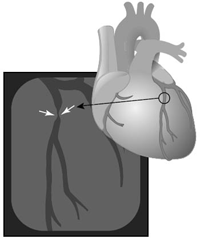
|
| Cardiac Catheter |
I was more or less awake during the whole procedure, getting to watch the dark black line of the catheter moving around on the scope beside me. I didn't know this particular surgeon, but it was obvious he was good. Usually, you can watch the catheter tip advance, then pull back, try again, pull back, try again and hit an obstacle. This evening I had the joy of watching a virtuoso performance, with the catheter smoothly advancing to its destination, twist and come to rest. Black dye squirted out, outlining the artery and its branches. The electrocardiogram correctly predicted the obstruction in the right anterior descending artery, and to general relief, the other atrerieswere "clean".
Probably because I got there so fast, plus swallowing an aspirin at home and chewing several in the Emergency Room, no clot had formed around the obstruction, which apparently was caused by a plaque of cholesterol with a split in it occluding the wall of the artery by bulging into the lumen. There seemed to be no clot behind the plaque or in front of it. The catheter had a stent over the balloon tip, which is to say it contained what amounted to braided chicken wire. The whole contraption gets opened up by inflating the balloon, then deflating and withdrawing it, which allows the artery to be held open by the unfolded chicken wire which remains in place. With the early versions of stents, fibrous scar tissue would grow over the chicken wire and block up the artery a few weeks later. Hence, the stent was coated with a chemical which prevents fibrosis. Unfortunately, this chemical also retards the growth of cells which line an artery on the inside, so coated chicken wire provokes clots. While I was still in the operating room, the solemn incantation was begun: I must take an anti-clotting drug every single day for a whole year, and if I missed a single pill, I could immediately die. I was to hear this incantation twenty times, so I guess they really mean it.
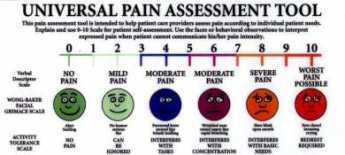
|
| On a scale from 1-10, how bad is it? |
Well, I was asked to call out a number from one to ten, indicating severity of chest pain. It had been "three" when I got to the operating room, even though it had begun as a "seven", and rose to "seven" several times during the procedure. Seven was my own invention; if I had to ask for pain-killer it was going to be an eight and would get to nine if I had to cry out. It never got worse than seven. When they pulled the catheter out of my groin, it was zero. It has stayed zero ever since.
It was a cause of some interest that my enzymes never rose. When heart muscle is injured, characteristic enzymes leak out and appear in blood tests; you can more or less measure the extent of the damage by the level it reaches. I had reached the emergency room so quickly the enzymes had not had a chance to rise. And the artery was re-opened so soon, they never did rise. For the first time in my life, my blood pressure was 250, so I guess I wasn't as calm as I let on. Somewhere during the procedure, the sweating stopped.

|
| Severe chest pain |
So, off to the cardiac care ward, where the custom is for each attendant to write his or her name on a whiteboard, while the date and time are prominently displayed for continuing orientation. They give you a phone so you can call your nurse, but my suggestion is to offer earplugs to drown out the continuous chatter at the desk. A patient of mine once called it the Racket Club. The food is, well, hospital food. Protocol says it should have no salt. I discovered that breakfast arrives on the dot at 9 AM, supper on the dot at 5 PM, lunch somewhere in between. I believe I understand the reasoning. Two days of this, and I'm discharged. Nothing to it, if you get there fast. Let me repeat, if you get there fast.
Since this light-hearted day trip is in sharp contrast with the six weeks of strict bed rest so routine in the days of my internship, not to mention the considerable mortality and disability that prevailed until quite recently, it justifies some reflection. As a medical student, I knew Andre Cournand and Dickenson Richards, who perfected the cardiac catheter. They were awarded Nobel Prizes, as was Michael Brown, who invented the statin drugs to lower cholesterol. Affable and modest men, they have saved millions of lives, now including mine. Or at least they did so, with the assistance of thousands of other doctors who perfected one by one the details of the little minute we danced in the operating room, each adding some little refinement, or eliminating some little hindrance to success. But, doggone it, you have got to get to the hospital fast.
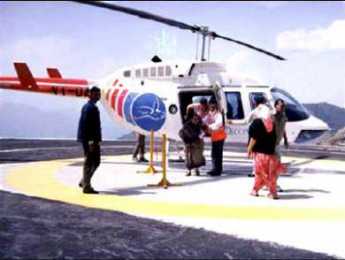
|
| Helicopter Dreams |
To do that, you have to give it some thought in advance; some community organization would also be useful. In my case, waiting for an ambulance would have slowed me down. Not everybody can live within a few minutes fast drive of a hospital, and not all hospitals are equipped to handle such cases. The range of effective rescue could be extended with helicopters, but you have to give some thought to where you would have to drive to find a place for a helicopter to land. Philadelphia is almost unique in having the largest evacuation company in the world, headquartered in Trevose, but it would take a lot of negotiation to arrange a system for the whole Philadelphia area. It just happens my oldest son was helicoptered off a mountain in Nepal this year (by an affiliate of this company), but his helicopter almost ran out of gas. These things can be done, and yearly evacuation insurance is about $200 a year, anywhere in the world. But it would take an awful lot of community planning and argue -- and maybe suing -- to make it happen. Is it worth it? Sure, but a little hard thought in advance might offer better solutions for most people.
Will Power
International Visitors Council
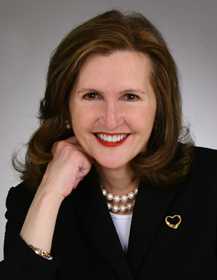
|
| Nancy Gilboy |
The President of IVC, Nancy Gilboy, tells us it stands for International Visitors Council, now approaching its 50th anniversary. As you might suppose, it is located at 1515 Arch Street, near the old visitors center. Philadelphia has a new visitors center on 5th Street, of course, and perhaps it takes time to move or maybe moving isn't in the cards. We had another Visitors center on 3rd Street that came and went, so proximity between Center and Council perhaps isn't as important as rental costs, or leases, or other issues.
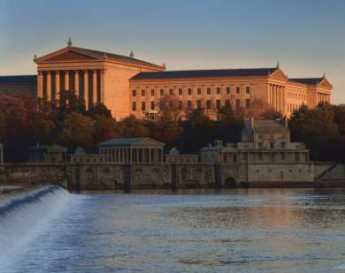
|
| Philadelphia Art Museum |
The Council has a modest budget, but a great idea. Anyone who has traveled much knows that you tend to follow the travel agent's set agenda for a town, you see a lot of churches and museums, but you can almost never get tickets for the local entertainment events, and you almost never meet any local people except taxi drivers and bellhops. That's even more true of young travelers, who don't have either the money or the experience to anticipate the issue, or enough local friends to guide them around the obstacles (This exhibit closed on Mondays, that event is all sold out, this event was spectacular, you should have been there yesterday, sorry we didn't know you were coming we have a wedding to go to, etc.). On guided tours, it is remarkable how few things seem to happen after 4 PM.
So, fifty years ago, some imaginative Philadelphia leaders got the idea that a lot of Philadelphia residents would enjoy taking some foreign tourists under their wing, maybe have somebody to know when they, in turn, make a reciprocal visit, maybe boast about our town a little. Furthermore, by getting involved with the US State Department, young visitors can be identified as potential future leaders in their country. If the guess is a good one, and the experience favorable, Philadelphia might prosper from the publicity and from the later return visits, now in the triumph of success. That was the founding spirit of the Philadelphia International Visitors Council.
So that's how it came about that Margaret Thatcher, < Tony Blair, the current President of Poland, and the head of the Russian Space Program were once visitors in Philadelphia homes. People who like to do this sort of thing tend to like each other, so the monthly receptions (First Wednesday at the Warwick) are interesting Philadelphia social occasions in their own right. Success begets success, and the CCP (originally Business for Russia) has affiliated itself, along with the Philadelphia Sister Cities Program, the Consular Corps Association, The Philadelphia Trade Association, and probably others.
Look at it from the visitors' viewpoint. New York has larger colonies of foreign nationals than Philadelphia does, but New York is an expensive place to visit. Washington has dozens and dozens of embassies, but a visitor soon learns the last thing an embassy staff wants to see, is a citizen from home. So those places aren't really a typically American place to visit. Indiana is plenty American, but there isn't much to see there. So Philadelphia has many attractions, lots of history, it's as thoroughly American as a city can be, and all it needs is someone to open up and show it to you. Cleverly organized, the IVC has undoubtedly put the Philadelphia stamp on many foreign visitors, without their exactly recognizing they are being told This is America. If the State Department is shrewd in its assessment process, Philadelphia will in time be held in high esteem by the leaders of a lot of foreign nations.
In the spirit of announcing that Philadelphia is where you can find America, my own little daughter astonished me at a dinner party by telling the assembly the following story:" William Penn was nice to the Indians, so it was safe to land in Philadelphia. Pretty soon, so many people landed here they had to move West to settle down. And, folks, that's why the people to the North of us talk funny, and the people to the South of us talk funny -- but everybody else in America talks like Philadelphia!"
A Just Society
Recently, Chip Kelly prodded us into trying something new; it was a straight-faced rise-from-your chair discussion of the meaning of a just society. Perhaps that should be capitalized: A Just Society.
It could be that the club has for so long adopted a habit of fixed presentations, that members begin to look around for a mechanism, any mechanism, to create a general conversation among a group of fellows who have grown to know each other very well. But the tone of the ensuing remarks suggests something more is afoot, very likely growing out of the current economic Recession, with the new President calling for disruptive Change of a redistributionist sort. The old saw has it that politics and religion are best avoided in conversations among friends, but once every eighty years cannot do much damage.
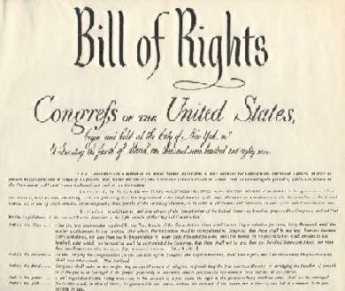
|
| Bill of Rights |
Allusions to the Marxist doctrine of "from each according to his ability, to each according to his need" were actually offered, and praise was openly made of the Chinese Communist system. To which were rejoined remarks about the 40 million Chinese who died in the Cultural Revolution, and the apparent effort to add a new right to the Bill of Rights, this one called the right to a job. This suggested right implies that people have a right to insist that someone else start a business; that's not how businesses have been started in the past. That such a broad new entitlement could be suggested at a time when the nation is plainly unable to afford the existing health and retirement entitlements -- makes it clear this discussion is not entirely about economics. People in the general public are tentatively feeling each other out on these sensitive subjects, and not always pleased with what they discover. Although the demeanor is invariably civil and tentative, one has to worry that hot words are not far away.

|
| Plato |
Even more remarkably, a lawyer stood to warn against excessive lawyering; the physician who followed him pointed out that all Utopias since Plato's have suggested that physicians should run any utopia -- a questionable notion in view of the examples of Che Guevara, or Assad the current dictator of Syria, or the behavior of German doctors under the Nazi regime. In fact, the behavior of medical students has traditionally been rowdy. It isn't the training that makes the characteristic personality of a physician, it is the experience of practice. Put all doctors on salary, and you may not get the same result.
Singing Waiters
<There was a time when the Victor Talking Machine Company in Camden had not been absorbed by RCA, and so there was a Victor Records Store in South Philadelphia, run by the Di Stefano family. In 1933 after Prohibition was repealed, the record store obtained a liquor license and became Victor's Cafe. Nobody named Victor has ever worked there, and ownership has remained in the hands of the DiStefano's. The record store used to be filled with the sound of operatic arias, and now the Cafe continues with opera-singing waiters. They are susceptible to requests for favorite arias, but they also spontaneously break into song when pauses in the demands of customers give them moments of rest. The walls of Victor's Cafe are covered with autographed photos of operatic visitors; the bartender is particularly proud that Pavarotti visited there, twice. The Italian food served there is quite good, and moderately priced; the Chianti wine comes in minimum-size two quart bottles.
This isn't an advertisement, it's a review. But there is really lots of fun in trying out what is essentially a South Philadelphia hangout at 13th and Dickinson. It's Italian, all right, but it is also a Philadelphia tradition.
Globalization
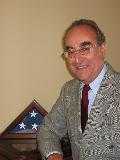
|
| Peter Aloise |
The Right Angle Club recently heard from one of its own members about the complex issues involved in the topic of globalization. Peter Alois defined globalization as the development of an increasingly integrated world marketplace, although enthusiasts call it Free Trade, and opponents say it interferes with Fair Trade. Although there can be local exceptions, globalization generally leads to lower prices, so consumers are pleased, producers are worried. Since Free Trade can be defined as international commerce without government interference, globalization can also be defined as a general reduction of government influence in trade. But whether you love it or fear it, globalization is a reality; it is here.
Hindrances to trade can take many forms, including subsidies to local merchants, who then can underprice foreign competitors. Carrying things to an extreme, the French fairly recently prohibited the use of American words. While the reasoning used to justify this intrusion into private life was the preservation of the beauty of native French phonetics, this unfortunate government adventure calls attention to the possibility that one of the main functions of local languages is to make it difficult for foreigners to understand what is being said. The Anglo-Saxon response tends to note the large expense of teaching foreign languages in our schools, so why doesn't the rest of the world just stop the nonsense and start speaking English?

|
| Dubai Waterfront |
There does seem to be something about this issue related to fair play, a thoroughly Anglo-Saxon concept. When corruption of trade practices around the world is ranked, it is notable that both New Zealand and Canada, which are ranked at the top, are former British colonies. Somalia, certainly one of least British of countries, is ranked at the bottom. No doubt the French would be offended by this observation. It is also irksome to Fair Trade advocates (ie Globalization opponents) that national prosperity is also fairly parallel to Free Trade policies, absence of corruption, and so on. It was George Washington (probably ghost-written by James Madison) who most famously framed the American Doctrine: Honesty is the best policy.
Some of the members of the Right Angle Club, an outspoken lot, took up the other side of the proposition. Underpricing by foreigners leads to competitive advantage for them and loss of jobs for Americans. This dislocation is the unfortunate side of creative destruction, and a compassionate government should assist its wounded casualties. Whether it should go to the lengths of raising prices for other Americans by hobbling the foreigners, is a more open question. In the passion of argument, it was mentioned that this country was founded on such principles. Well, it would be hard to find anything written in the Constitution or spoken in its debates which supports that claim. But it must be admitted that the new nation wasted little time in creating new tariff protection for struggling new American manufactures, but took an awfully long time to get rid of what protective tariffs it already had. The confusions of the newly developing Industrial Revolution were perhaps not the best time to develop enduring principles of trade fairs, and thus we should not necessarily be held to them forever. But there is certainly room for the argument that a nation may need a certain set of policies when it is new and struggling, that are not necessarily appropriate when it becomes rich enough to claim to dominate world trade.
Proton Therapy at Penn
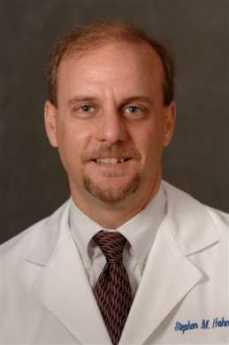 |
| Dr. Stephen M. Hahn |
According to Dr. Stephen M. Hahn, Chairman of the Radiation Oncology Center at the Hospital of the University of Pennsylvania, the means of delivering a dose of radiation to cancerous tumors has advanced a remarkable amount since the first linear accelerator was used to zap tumors in the early 1960s. The Right Angle club was host to Dr. Hahn who is overseeing the beginnings of this new technology called proton therapy at Penn where the Perelman Center for Advanced Medicine and the Roberts Proton Therapy Center will come on-line in November of this year. The center will be a state-of-the-art facility laid out in such a fashion that patients will be central to all the treatment areas and have access to every type of cancer treatment in one location.
 |
| Radiation Oncology Center at UPENN |
Over the years that radiation therapy has been used many advances have been made in delivering radiation using various methods of production of the radiation itself. The magnitude of the beam has been reduced with different sources and the accuracy of delivery has also improved. But one thing that has always been a problem is that images of the tumors were taken with technology that produced flat slices at right angles to the subject, the position vertically was not able to be determined which meant that the radiation could only be directed straight through the surrounding tissues and into the tumor which, of course, ensured that the surroundings got a good dose as well as cancer itself. Intensity modulation (IM) of the beams helped a good deal to ensure that less of the tissue on the far side of the growth was damaged but the collateral damage was still severe and often bad enough to require hospitalization because of the therapy itself.
With the improvement in the past 10 to 15 years in imaging technology it is possible to now create three-dimensional images of the tumors along with precise position data within the patient. This, along with improved beams of radioactive particles which are more finely focused and targetable, has allowed treatment with a good deal less damage to the healthy tissues surrounding the cancers because the beams can be directed from a number of directions thus allowing a full dose of radiation to reach the tumor while spreading out the amount received over the surroundings.

|
| Superconducting Proton Cyclotron |
Proton radiation, the technology of the new equipment being readied, further enhances the delivery in that it is possible to focus the beam ever more finely and, best of all, to use a level of radiation that is up to 70% less than even the IM method. Scans showing how the new technology lessens this collateral damage indicated that there was, indeed, still damage to healthy tissue but only to that very small area which was right up against the tumor, not throughout the entire surrounding volume.
It turns out that proton therapy is about two to three times as expensive as traditional therapy. With the lesser danger to the patient and fewer hospitalizations required because of damage caused by the treatment itself however, the cost is mitigated somewhat and this should improve with time. Proton therapy isn't indicated for every case but where it is it appears that cancers are going to have a tougher time than ever before at wreaking their damage and taking lives. The cyclotron which accelerates the protons to the proper level for treatment will operate 16 hours a day, Monday to Friday and 8 hours on Saturdays. Approximately 200 patients a day will be treated.
Saving the United States
Anyone crossing the Walt Whitman Bridge into Philadelphia or driving along Columbus Boulevard along the port's edge can't help but see two red smoke stacks rising above the pier buildings at a rakish angle. They belong to the SS United States, the fastet ocean liner ever to ply the Atlantic or any other sea. On her maiden voyage in 1952 she traveled between Ambrose Light Ship in New York harbor and Bishop Rock off Cornwall, UK, in 3 days, 11 hours and 40 minutes topping the previous record held by the Queen Mary by over 10 hours, setting a new record that still remains unbroken. They teach people at Annapolis that the top speed of a naval vessel is related to the length of the ship at the waterline. Contrary to what you might expect, the bigger the boat, the faster it is capable of going. That's just the theoretical limit, of course, and things start to shake a little when you approach that limit, which is a function of the square root of the length. Submarines generally can't outrun a liner, so in wartime liners travel alone instead of in convoys. But now this ship unhappily is a derelict headed for the scrap yard unless efforts to raise the money necessary to bring her back to life are successful. Dan McSweeney, vice president of the SS United States Conservancy whose father emigrated from Scotland to work aboard the ship, gave the Right Angle Club members a heart-felt slide presentation of why he thinks the United States must be saved.
During WWII ocean liners were pressed into service as troop carriers; not many people were taking pleasure cruises at the time. They were fast, reliable and able to carry thousands of troops to overseas destinations and thus allow warships to be used to fight rather than as transports. The SS United States was built to Navy specs right from the start to fulfill this mission should it ever arise and yet be a premier ocean liner with all the amenities people expect from a cruise ship. The idea worked out well and she was a spectacular success with a long list of famous people who have walked her decks - including several Right Anglers who still have fond memories of their crossings. The ship was a regular player in the ocean liner trade right up until 1969 when she was decommissioned by her owners and laid up at Newport News where she was built between 1950 and 1952. Since then she's had several owners and been idled at a number of ports. She's presently owned by Norwegian Cruise Lines, a company that bought her in 2003 with serious plans to put her back in service with new engines and a total refitting. Alas, the costs were astronomical and given the current economic conditions the plans have been dropped by NCL so here she lies awaiting her fate.
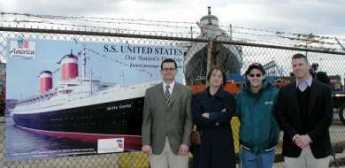
|
| (L-R) Richard Rabbett, Susan Gibbs, Jeff Henry, and Dan McSweeney |
The SS United States Conservancy was formed to ensure that her fate is not to be converted to metal cans or whatever else thousands of tons of scrap metal might be used for. One doesn't have to be an aficionado of ocean liners to be entranced by the United States; she's not only big, beautiful and sleek but a real symbol of the power and glory that all Americans have come to associate with their country. The founders of the Conservancy all recognize these attributes and have family ties that make them truly passionate about saving the ship. Besides Dan, whose father was noted above as having come to America to work on her, the president of the Conservancy, Susan Gibbs, is the granddaughter of William Francis Gibbs, the naval architect who designed the ship. Another board member, Charles B. Anderson, is the son of the longest-serving master of the United States, Commodore John W. Anderson. So, it's not too surprising to hear of their pride and zeal relative to the ship. They are also experienced scholars, historians and fund raisers so we can hope that something good can yet be done.
Several PBS documentaries have been produced to educate us Americans, frequent meetings with city planners and philanthropists take place, especially in Philadelphia and New York City where the greatest interest currently lies and where maritime museums and displays are already in place due to their own history. In the meantime the present owners are paying Philadelphia Regional Port Authority $1000 a day for docking fees and simple maintenance while awaiting public money to be found. Because of previous owners having stripped her in their efforts to recoup their costs, she's really just a shell at present and whatever is finally decided to make of her (if she's saved at all) will be a project almost as big as her initial construction. Her initial cost to build in the early 1950s was $78 million. To bring her back to life, estimates range from a low of approximately $200 million all the way up to $700 million. This writer fervently hopes that one day we are lucky enough to once again walk the decks of the SS United States as a museum piece and symbol of the pride of the American people.
Little Town of Bethlehem
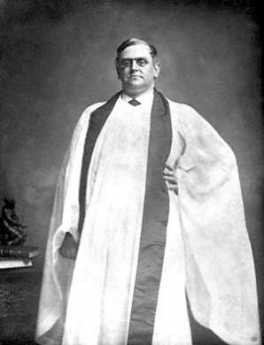
|
| Reverend Phillips Brooks |
The Reverend Alan Neale and his attractive wife recently addressed the Right Angle Club about the historic church on Rittenhouse Square, its famous Rector Phillips Brooks, and his famous Christmas Carol Alan comes from England by way of Brookings, South Dakota, and we certainly hope he will make Philadelphia his permanent home.
>Holy Trinity is built of brownstone, which thus reflects the character but the not invariable appearance of Episcopal Churches in America and for a long time fit right in with the brownstone houses of that part of Philadelphia. Since ample supplies of brownstone were available from the region of Hummelstown, Pennsylvania during the Nineteenth century, it was then a local fashion. Holy Trinity also has the first American carillon. Although carillon is very popular in the low countries of Europe, they only came to America in the early Twentieth century, the very first being the one in Holy Trinity. The most modern versions are run by electric controls, but the traditional ones require pounding a heavy wooden frame to ring the various bells. Carillon players in that tradition tend to resemble blacksmiths and have a similar directness of speech.
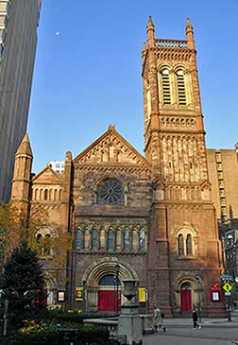
|
| Holy Trinity Church |
Phillips Brooks spent eight years as Rector of Holy Trinity during the Civil War, where his fame as a preacher spread far and wide, eventually resulting in his being called away to be Bishop of Boston. Before the days of amplifying systems, his physical stature was of considerable use in swaying large audiences. He was 6' 4" tall and weighed nearly 300 pounds. Holy Trinity is quite a large church, but Brooks would fill it to capacity three times every Sunday. He was an enthusiast for Abraham Lincoln and strongly anti-slavery in a city that still harbored a great deal of sympathy for the South. He travelled to Gettysburg to minister to the wounded, and after Lincoln was assassinated, preached a notable funeral oration as the funeral train paused on its way through Philadelphia to Springfield, Illinois.
Brooks was an energetic foreign traveler, often gathering travelog material for his sermons. He felt that spending Christmas Eve on the hills overlooking Bethlehem was the inspiration for composing a poem, Oh, Little Town of Bethlehem which was set to music by the church organist Lewis Redner, and has become one Christmas Carol whose words just about everyone knows by heart.
Philadelphia Gets the Business

|
| Bernard Dagenais |
The list just keeps getting longer and longer. The list of reasons why our beloved city is such a great place to live near. What's not to like about the history, the music, the art, the architecture, the location and you name it? We at the Right Angle club were apprised of another goodness at our June 26th luncheon when Bernard Dagenais, editor of the Philadelphia Business Journal, spoke about the current economic conditions and how we in this area are fortunate to have a healthy business climate that has allowed the region to weather the storm better than many other major centers in the U.S. To be sure, it's been no picnic. Unemployment in Philadelphia County is currently 9.7% while the whole of Pennsylvania is suffering at 8.2%. Compared to the likes of California which has hit 11.2%, though, we're not doing so badly. What we have in this region is a true diversity of business that many cities cannot match.
Our region's major work-force breakdown runs like this: 28% - Office oriented 26% - Manufacturing 23% - Hospitality, retail, tourism, etc. 18% - Health and education Rather than having our work force concentrated in just a couple of areas we are strongly represented in high-tech manufacturing, pharmaceuticals, bio-tech, consumer products and financials to name only a few. Greater Philadelphia has always had a strong interest in education and can point to having a strong, well-trained work force that can be tapped for just about any efforts imaginable.

|
| Convention Center |
Recent initiatives that are being pursued and which have come to fruition are graphic examples of our willingness to work.
Mensa
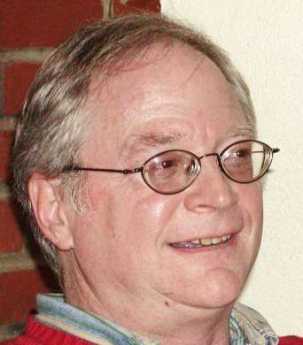
|
| Peter Stevens |
Pete Stevens, the president of the Delaware Valley chapter of Mensa, recently visited the Right Angle Club and entertainingly told us about his organization. Mensa is the Latin word for table, alluding to a round table, as in discussion group. It is primarily a social organization of people who are very smart but are otherwise drawn from all races, genders, and levels of income and profession. To be eligible to join this organization, an applicant must somehow prove that he or she is in the top 2% or percentile of the population in intelligence. The organization has a standardized 90-minute test but will accept certified copies of evidence from a long list of other established tests of intelligence, to the effect that the applicant is in the 98th percentile of intelligence.
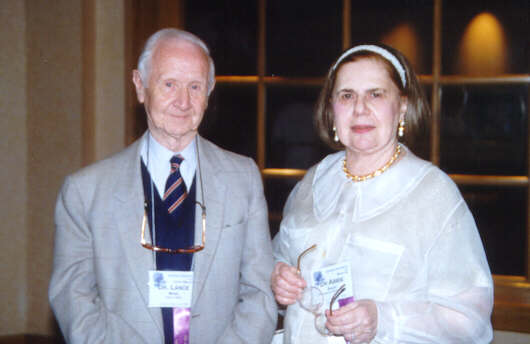
|
| Dr. Lance Ware |
Mensa was started in England in 1946, by two lawyers, Roland Berrill and Dr. Lance Ware, who also had a scientific degree. The English have a fondness for classifying the population; aristocracy is sort of a public label of superiority, which most people would admit seems to have a hereditary tendency. At Oxford, there is All Souls College, which is five or six hundred years old and admits two new members a year. The eligibles are selected from among the valedictorians of the thirty-nine component Oxford colleges, and once admitted to All Souls, spend most weekends for the rest of their lives eating dinner and talking to each other "in the hall". It would be interesting to know the scores on the Mensa test of such intellectual elites, although one supposes they have nothing to gain by taking the Mensa test, but -- from their viewpoint --might just happen to have a bad day, and flunk it. Bad show.
<

|
| Mensa Test |
There are now over 150,000 members of Mensa International, enrolled in any of over 200 SIG, or special-interest-groups, ranging from butterflies to astrophysics. In Philadelphia, they have a monthly meeting with speakers, dinners, and outings. There are a scholarship fund and various other volunteer activities of a Philadelphia character. They now have a major handicap that Senator Fumo is a member, but in fact, that is not completely surprising.
Cost Shifting: Indigent Care Out, Outpatient Revenue, In
The CEO of Safeway Stores recently offered his company's preventive approaches as an example of what the nation can do to reduce health costs. He's undoubtedly sincere, but quite wrong; Safeway just shifted costs to Medicare. This is only one of several ways, major ways, cost-shifting is misleading us. Let's explain.
Average life expectancy is increasing at more than two years per decade, but of course, people eventually die. Since health care costs are heaviest in the last year or two of life, extending life will soon push nearly all those heavy terminal costs from employer-based insurance -- into Medicare. To die at age 64 costs Blue Cross a lot; but to die at 65 gets Medicare to pay for it. Either way, the cost is exactly the same, it doesn't save Society as a whole any money at all. Let's put it another way: dying at age 64 costs the employer and the employees, but dying at 65 costs the taxpayers. This means Medicare costs will surely rise, but in this case, it's a reason to rejoice.
Increasing longevity is constantly pushing more costs from employers to Medicare, and not just in Safeway; the prospect is that soon substantially all major sickness costs will shift into Medicare. (To explain the failure of most employer insurance premiums to fall comparably in response to this shift, one must look elsewhere). But just a minute. Medicare is 50% subsidized by the government, and the employer writes off half of the cost as a business expense. That ought to mean it doesn't make much difference to anyone involved, except for one thing. Some employers have two employees and some have two hundred thousand employees. The amount of tax write-off is multiplied by the number of employees, so some employers can only write off a little, while an occasional employer might even make a profit on using health insurance for calisthenics. Economists agree that fringe benefits eventually and proportionately come out of the pay packet, so ultimately the employed patient benefits from the reduced bill, his employer pays less, and the Medicare costs the taxpayers more.
<But instead of going down that trail, let's look at the second form of cost-shifting. Government payers and a few other monopolists are able to pay hospitals less than actual costs and get away with it. The worst offenders are state governors administering Medicaid, where the underpayment is roughly 30%, in spite of federal reimbursement to the states for most of it, at full price. The resulting profit is used for various state purposes, mainly nursing home reimbursement. For the most part, such diverted funds are used for purposes not easily eliminated, so it is unlikely there will be much cost reduction for the government if the scam is acknowledged and merely shifted to a different line in the ledger. To avoid bankruptcy, hospitals raise the rates for other health insurance plans -- and the uninsured. Employers are paying for most of it, so they stand to gain from reform, only to face higher state taxes as matters readjust. We have yet to learn where these costs will shift if the federal government takes over the costs of the uninsured; the current Obamacare plan is to shift 15 million uninsured persons to Medicaid. To a major degree, the federal government and its taxpayers are already paying for a lot of this uninsured cost, through the Medicaid shift. So its present dilemma is whether to continue to pay for it twice.
There's still a third cost-shift. In 1983, Medicare stopped reimbursing hospitals fee-for-service (itemized inpatient bills are still prepared but are meaningless fictions) and for thirty years has paid by the diagnosis, not the service, for inpatients. Consequently, per beneficiary inpatient costs have only risen 18% in five years, while outpatient costs have risen 47%. Costs are not the same as prices, which are even worse distorted. To a large extent, changes in costs are really changes in accounting practices, driving changes in actual practices. Skilled nursing and home care costs are rising even faster. When you hear fee-for-service payments attacked, it is this apparent overpayment of outpatient costs which is the source of the complaint. But to pay out-patient medical costs in any way other than fee-for-service would imply an almost unimaginable restructuring of the medical system, without any proof it would save money. It will be very interesting to learn what contorted proposal is about to emerge.
 Medicare +6% Medicaid -30% Private Insured +32% 
|
| 58% of Hospitals Lose Money |
Not only do these shifts provoke inpatient nursing shortages, but they also start a war for patients between hospitals and office-based physicians. Hospitals are winning this war for business, but are losing money doing so. If the public ever demands a stop to loss-leaders, net insurance premiums will probably rise. The difference between a hospital which makes money and one which loses money is based on whether there is enough extra out-patient revenue to compensate for the hidden tax which the state effectively imposes on hospitals in order to pay for nursing homes. The obscurity of the present payment system is quite expensive, and the present beneficiaries of it are the Medicaid nursing homes. Obamacare essentially provides health insurance to 15 million uninsureds by the process of placing them on Medicaid, so the consequences are going to be an interesting juggling act to watch.
 5-year Change: Inpatient +18% Outpatient +47% 
|
| 5-Year Hospital Costs |
Just notice, for example, that neither Medicare nor private health insurance pays below costs if you look at total national balances. Private insurers are paying hospitals 32% more than actual inpatient costs, while Medicare is paying 6% more than national cost. And yet 58% of hospitals are losing money. The magic in this formula lies in the losses incurred by state Medicaid but shifted to other payers. It could fairly be said we are just looking at a maldistribution of the uninsured, as a cost, and a maldistribution of non-inpatient revenues, as a profit, among the nation's hospitals. To what extent such maldistribution reflects uneven patient quality, as the loser hospitals claim, or provider inefficiency, as the winner hospitals would say, -- merely starts a distraction of attention which could last twenty years while we examine it.
And disruptions enough to take decades to fix.
Rejecting Preventive Health Care for Good Reason
WHILE we debated in 2010 whether to disregard what could be afforded, and provide sickness care to all, the idea subtly changed to providing "health care" for all. That is, the proposal was not merely to expand sickness care to everyone, it included an indefinite expansion of what everyone would get, and who would provide it. Medical care is provided by physicians, sickness care is provided by doctors, nurses, and hospitals, and healthcare is provided by a much larger undefined group of "providers". No wonder it costs more, and therefore a surprising number of people are unsure they do want all of it. It's almost a certainty that most people do not want to lose control of this definition, at least if it is to apply to them, personally. The issue centers on "healthcare" versus sickness care". How's that, again?
 Preventive Health Care poses unique issues for seniors. 
|
| Dr. Fisher |
For example, the notion that preventing disease is superior to treating disease, goes back at least to Benjamin Franklin. Arguing that the Pennsylvania Legislature ought to help build the nation's first hospital, Franklin offered the truism that it saves money in the long run to treat people early and get them back to work. Franklin could hardly have foreseen that it isn't always true. Preventive medicine implies it is cheaper to spend small amounts, possibly every year, for many people, than to spend large amounts for a few. It's a matter of arithmetic, of course, and doesn't always have the same answer. When the math works against a preventive approach, it's usually argued the gain in health is worth it; but that's not invariably the case, either. Once a person ceases to be an infant, the equation rebalances. And as an individual approaches end of life, his renunciation of what it takes to prolong life gathers more respect. It's a conflicted opinion, of course. Older people are outraged by any suggestion their lives do not deserve to be prolonged, but still, outspokenly prefer to die rather than wear a colostomy bag, or a respirator, or be fed with a spoon. If they are Jehovah's Witnesses and refuse transfusions, that too, commands more respect when they are elderly. This is a familiar problem, not a new one. What's new is more subtle and pervasive.
The public probably does not fully appreciate the disappearance of what might be called capricious diseases, caused by the operation of chance, or God's will. These are fatal illnesses like heart attacks, strokes, epidemics, and other things not anyone's fault. Except for cancer and Alzheimer's Disease, most really common serious illnesses which remain, are to some extent self-inflicted. Smoking causes lung cancer, alcoholism causes accidents and homicides as well as cirrhosis of the liver, taking recreational drugs damages lives, unprotected sex causes HIV. Obesity causes hypertension and diabetes, neglecting your medicine undermines treatment. If this keeps up, we are going to see the day when every obituary will seem too shameful to print. Poor Jud is dead; it's his own fault.
It's maybe even worse than that.The 2000-page Obama care plan was too complicated for even the Congressional committees to understand. But the public was not hostile for technical reasons, the public was irked at the idea. All the President's celebration of saving money through mandatory preventive care provoked the public to tell him, Get off my back. Almost every smoker has tried at least once to quit, absolutely every obese person has repeatedly tried to lose weight unsuccessfully. It's hard, let's see you try it. And now it goes beyond nagging, we are going to take the position that every person with a self-inflicted disease is costing the nation money we can't afford. The country has a right to punish people who drive us to bankruptcy. Let's have some Wellness police, and fair but firm punishments. Is that really what Obama has in mind? Well, sir, you just get off my back.
Even so compliant and dutiful a person as my late wife declared that when she got to be seventy, she was going to try marijuana. The fact that she actually lived thirteen years longer without doing it, did not change her basic attitude. When you get to a certain age, many of the old rules don't apply to you, doggone it.
Inside the Big House
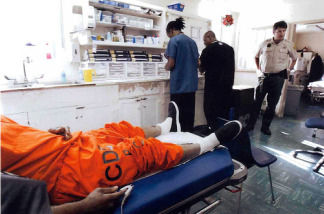
|
| Medical care inside a prison |
The Right Angle Club was highly honored recently to be addressed by Peter Binnion, MD, the former Chief of Cardiology at the Pennsylvania Hospital, distinguished librarian of the Shakspere Society, and well-known former Main Line physician. Peter is now, hard to believe, Associate Director of a state prison medical program. One of the members of the audience asked him straight out, "Why are you there?"
At a time when prison medicine is widely, and correctly, regarded as a generally deplorable system, it is hard for the public to understand the sense of duty which impels at least a few of the profession to try to improve matters. And it is particularly difficult for the lay public to understand the attraction for a well-trained academic physician to work in an environment of severely ill patients. In a sense, it's like the old days.
And Peter slyly pointed out, it may be somewhat like the future if we aren't careful. He artfully repeated the anti-medical care harangues which are now commonly issued by various liberal politicians, denouncing the extravagant care we are supposed to provide, and the uncaring attitude toward the uninsured sick. Having resonated with any left-leaning members of the audience, he proceeded to describe what things are like when the government provides the care, and how it feels to observe the limitations of a real bureaucracy. Just for a start, he isn't allowed to call himself a doctor. He's a provider of care. And to go on, not only are the prisoners three to a room designed for two but one-quarter of those without cells, sleep on the bare floor,

|
| Delaware State Prison Patch |
Over ninety percent of the prisoners are taking illicit drugs; their ingenuity in smuggling simply passes belief. What's called drug detoxification among new inmates gets briskly to the goal. Our speaker delicately avoided the disagreeable notion that study after study has shown that illicit drugs in prison are almost invariably smuggled in and sold by the guards. For them, it's just a source of supplemental income, justified in their minds by low pay for unpleasant work. Lots of the prisoners have HIV infection, although not as many as depicted in rumor. Unless a disease is life-threatening, treatment is not encouraged. Hernias are not repaired, for example. And so a physician working in this environment is intended to spend all of his time with life-threatening conditions. Most physicians would shame-facedly have to admit this makes for an exhilarating professional experience, and it is indeed the sort of environment in which post-graduate medical training once took place, almost everywhere. Up until now, Peter had never seen a case of Hepatitis C. In the past two years, he has treated six cases. Diabetes is almost always out of control because it is absolutely forbidden to allow the prisoners to have the needles to give themselves insulin. Sharps, you see, is prohibited.
It's a little disconcerting to be given lectures on how to behave if you are being held hostage, but the fact is that the prisoners universally treat the doctor with great courtesy. You know they are always looking for drugs, and you know they regard the medical system as a soft spot in the security system so it's a good place to launch an escape attempt. But regardless of the motivation, Peter observes at least as much civility in these patients as in the Main Line office. The doctor really doesn't want to know the reasons for imprisonment, and the prisoner certainly doesn't volunteer it, so the topic just doesn't come up.
Three goals are maintained, above all others, by the prison authorities. The suicide rate is regarded as a measure of the prison system, so extreme measures are taken to prevent it, or to prevent suicide from being successful when attempted. There is a very high rate of schizophrenia among the inmates, which probably reflects the deplorable state of psychiatric hospitals following the 1983 Budget Reconciliation Act. The second overriding goal is to protect the guards ("officers") from attack, so that scissors, hypodermics, and things which could remotely be described as a "sharp" are scrupulously sought out and eliminated remorselessly. The final goal, of course, is to prevent escapes, which have become the public measure of whether or not it's a good jail. The precautions taken to prevent, thwart and punish escape attempts hang heavy in the air.
All legislatures hate prisons; they cost too much. Since budget restraints lead to many of the nastiest features of prison life, budget restraints enhance the punishment. How much these two ideas reinforce each other is hard to say, but one thing is clear. Individually, people are pretty decent; collectively, Society is a bum.
Principles of the Command of War
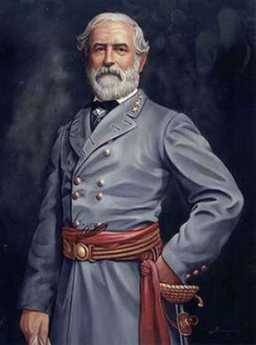
|
| General Robert E. Lee |
COMPUTER war games now consume a great deal of time which teenaged boys ought to be spending on homework, but study of the underlying principles of commanding an army is a major part of the serious curriculum at West Point. To be good in this course means promotion in the officer corps, and putting principles into successful action creates a few famous heroes for the history books. Lawrence E. Swesey, the founder and president of American Military Heritage Experiences, recently fascinated the Right Angle Club with an analysis of Generals Lee and Grant, both West Point graduates, putting the principles to work in the Civil War. Conclusion: Grant was the better general. It was Henry Adams, the manic-depressive historian, who diverted attention away from the principles of war, to such issues as Grant's short stature, taste for whiskey, and poor performance as an Ohio farmer. To be snide about it, a case can be made that Grant was a better writer of history than Adams, as well as a better general than Lee. However, probably neither Ulysses Grant nor Julius Caesar would be considered great historians if either had lost the wars they so famously described.
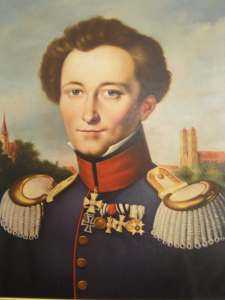
|
| Carl von Clausewitz |
The nine principles of war used by the American military derive from the Prussian officer Carl von Clausewitz, and are also used by the British, who add Flexibility as a tenth. The Chinese and Russians go on to add Annihilation to their list, a thought worth pondering. French military schools base their training on 115 principles laid out by Napoleon, which are presumably ten times more difficult to remember in the heat of battle if indeed anyone can remember anything when the enemy starts taking aim. In any event, the first universally agreed principle is to have an objective that is both effective and achievable. The second is deciding to take offensive or defensive action, the third is to apply sufficient combat mass at one critical time and place. Maneuver is the last of the four main principles. The economy of force, Unity of command, Surprise, Security, and Simplicity are five lesser principles, used to achieve the four main ones. Using these lines on the scorecard, how did Robert E. Lee and Ulysses S. Grant score on the fifteen major battles of the Civil War?
To compare the two generals, there is the difficulty that they only opposed each other in five battles, and each was the clear winner in two of them. In the battles where they faced other generals, both Lee and Grant won some, mainly because the opposing general did the wrong thing and lost the battle. The score comes out roughly even and gets complicated when giving more weight to winning bigger battles, less weight to smaller ones. Lee gets more glamor, because his style was to attack, even attacking just after he seemed to be losing. Lee won one battle when he was outnumbered, two to one.
But Grant won the war, and that should count for something. Both Lee and Grant knew the superior resources of the North would ultimately overcome the South unless the North made some mistakes, or just got tired and quit. Apparently Lincoln also understood this, and immediately offered the top job to Grant after an interview in which Grant came right out and said so.
Apparently, there is one more principle of war that isn't on the list. You play the hand you are dealt, after counting your cards carefully. In contract bridge, the game is always played with fifty-two cards. It isn't that simple in a war, where you stack the deck if you possibly can.
Reforming Health Reform, New Jersey Style
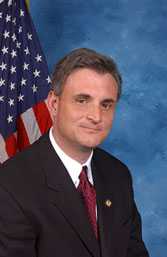 |
| Congressman Robert Andrews |
A single e-mail to constituents, and no other communication visible to the general public, announced a town hall meeting with our Congressman, Bob Andrews, on the campus of Rowan University, from 6 to 8 PM, August 24, 2009. The subject was to be Health Care Reform Legislation. On arrival, it was hard to find the auditorium in the square mile of new college campus, and only a small sign entitled "Event" indicated the place to park. Lots of cars.
By counting seats in a row and multiplying by the number of rows, the University Auditorium held 3000 people, but at 6 PM it was difficult to find a vacant seat. The doors were almost blocked by two lines of people standing to speak at microphones in the center of the hall, snaking all the way out past the television cameras and then out the door. These people were strangely silent, preoccupied but not rude, apparently rehearsing their speeches. In the lobby outside the doors, several workers were distributing posters showing "Thank You!", checking people off on lists of some sort. Many of those who got posters were wearing red T-shirts emblazoned with something or other.
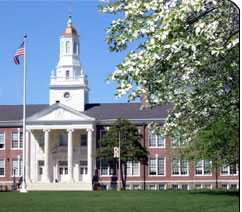 |
| Rowan University |
When I finally got a seat inside, it was behind a whole row of such T-shirted poster-holders, mostly but not entirely of the black race. The Congressman was giving a little speech to the effect that he was one of the committee members who wrote the bill, so of course, he had to support it. Strange, that as a member of Commerce and Labor he was working on a bill which traditionally is the province of the Subcommittee on Health, of the Ways and Means Committee. In any event, that gave him the ability to explain some of the languages which were a little too hard to understand. Several in the audience shouted out something unintelligible at that point, but mostly the audience sat in silence, waiting for the questions. He soon opened it up for questions, because he wanted to know what his constituents were thinking.
Although a few inevitably wandered off the point, questioners were confident, moderately deferential, remarkably effective. No matter how it was stated, and no matter how it began ("I have always voted for you, Congressman"), they were at the microphone to run a sword into him. To some extent, posting the entire bill on the Internet had changed politics. One old man, reading from his papers, said that page 343 says, etc; to which the harassed Congressmen blurted out, "That isn't true!" But the old man held his ground, "Oh, yes, and what else isn't true, that's written in the bill?"
Our congressman represents a working-class district, as clearly illustrated by his previously running for Congress without opposition. In searching for the reason this solidly Democrat audience was so antagonized, one gathers they generally have Unionized health benefits and feel threatened that ensuring the "illegals" will be paid for by impairing their own insurance. Somehow they feel that anyone who denies it is lying to them. ("It isn't what's in the bill, it's what will be in the bill ten years from now.") Except for college professors, Union members have the most luxurious health insurance coverage in America and are accustomed to boasting of it. Somehow, this privileged position drowns out their envy of rich people. When told that only the top x% of the country would have its taxes raised, one man bore right in on the Congressman. "You never heard anyone asking a poor man to give him a job". (Yeah, right, right on, Yeah.)
Although the people in red shirts holding posters put up a fight for fifteen minutes or so, they soon subsided out of recognition of who "owned" the room, and the remaining three hours of "questions" were almost uniformly negative. After an hour, the television cameras left the room, and at that signal, the people in front of me wearing red shirts also left. After a succession of speakers praised physicians somewhat excessively, a couple of physicians got up and made a poor showing at the microphone. One of them, a fat woman, had the poor judgment to tell these folks that many diseases like diabetes were self-inflicted, but was to hear back that it would help if our President would himself stop smoking and leave the rest of us to mind our own business. Two women who proclaimed themselves single mothers were no better treated..
At 9:30, a meeting scheduled to end at 8 PM still had a thousand people in the audience, and fifty at the microphones. But I had enough. They made their point. All that remains is to see how fairly the television editors extract significant clips and to find out how the rest of the nation feels.
LATER FOOTNOTE: As matters turned out a few months later, this national legislation had more of a local New Jersey effect than the audience could have guessed. Mandating health insurance for 30 million uninsureds, Obamacare accomplished it for 15 million of them by forcing them into the state Medicaid program, which is widely acknowledged to be the worst program in American medicine, because it usually is the most under-funded. New Jersey residents are firmly opposed to anything which raised their already high local taxes and will focus intently on the attempt in the coming lame-duck session of Congress (November 2010) which intends to transfer federal money to states to pay for Medicaid, and which is given only the narrowest chance of success. Republican Governor Christie deftly split the industrial unions from the public sector unions with the remark, "Every time they get a raise, you get a tax increase." It was hard to answer.
Tour of Duty in 'Nam
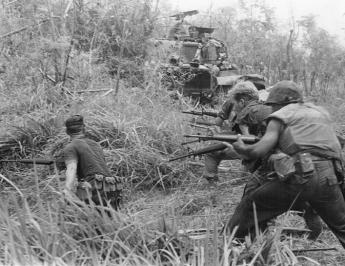
|
| Vietnam War |
Col. Dan McCall talked to the Right Angle Club about wartime experiences in Vietnam recently. He really didn't want to, though he was being asked to talk about retirement planning, or asset allocation, or something else he knew something about. But the Program Chairman this year is also a Colonel, and wasn't about to be talked out of it; he wanted Vietnam, sir, and nothing else. So, for the first time in forty years, he did. He hadn't talked about it with his family or, during a career rising from Lieutenant to Colonel, with his associates in the National Guard.
Perhaps a little slow and fumbling at first, we heard of going to a place where it's 120 degrees in the shade, every day. Where he fainted from a heat stroke on the first day off the plane in Saigon, and soon found that it happened to everyone. Within thirty days, every single person had dysentery. The plane that lands troops in Saigon doesn't turn off the engines, and takes off as soon as the last man deplanes. As well it might because it attracts sniper fire as it takes off. Once there, the only form of transportation for anyone going anywhere is by helicopter; plenty of peasants with chickens in their laps are taken along, too.
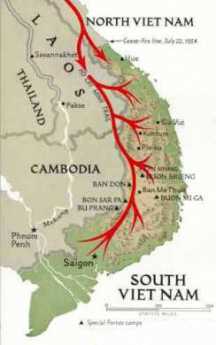
|
| Ho Chin Minh Trail |
His unit, the 82nd Airborne, was deployed to the west of Hue, the ancient capital. The country is near the border with North Vietnam, and the land is a fairly narrow strip between the ocean and the Laotian border. The Ho Chi Minh trail, where the enemy comes from, is just over the border inside Laos. Our troops never go there, but B-52 bombers go there plenty, leaving impressive craters in the ground. The unit was mortared every night, and rockets made an impressive noise as they went overhead toward Hue. The American forces almost never went out at night. Deployments in the jungle lasted 45 days, without baths or toilets; mostly, you walked into the enemy by accident on the trail. One of the prizes was a Chinese officer, carrying much better maps of the region than the American Army had. One night, sniper fire seemed to be coming from a small island in the river, and the response was to send thousands of shells back, filled with 3-inch steel darts. The next morning, every tree on the island was normal enough on the Laotian side, but nearly covered with steel darts on the Vietnam side. Although the command from headquarters was to report a body count, there were no bodies to count. At the end of one 45-day deployment, there had been no food or water for three days. When the "ships" came to take them out, there was a celebration with rice wine. You make rice wine by soaking stalks of rice in water, letting it ferment. The water is pretty murky, to begin with, and gets worse as it ferments; you have a good time, anyway, with the villagers bringing in a pig to roast.

|
| 82nd Airbourne Patch |
The CIA had its own private army, Rangers and Special Forces. There were local mercenaries, mostly from Thailand. The 82nd Airborne - The All American Division - had a tradition of parachute jumping in every military engagement since World War II, but in the jungle there was no place for, or point in, jumping. But at the end of their deployment, they jumped once, anyway. When you got home, the movies were kind of a joke, but Apocalypse Now came close to giving the right feeling. Although of course people asked what it was like, you didn't talk about it. No one did.
One member of the Right Angle Club who had spent a year there, muttered an answer. "And people didn't really want to hear about it, either."
Country Auction Modernized
Only a decade ago, the Quakertown exit of the Pennsylvania Turnpike made possible a quick trip from the city to the country, letting you off in the cornfields between Sumneytown and Lansdale. Today, the rush hour traffic is as bad as anywhere else, even on the four-lane express highway known as Forty Foot Road. A comfortable two-lane highway would be about forty feet wide, so presumably, the name denotes what was once a modern miracle of a two-lane highway, in this case until quite recently. It's all built up for miles, but almost all the commercial buildings are new. Exurban sprawl has positively lurched across the landscape, making prosperous people rich, and poor people prosperous. It won't be long before the housing subdivisions demand traffic signals to protect the school children, speed limits to reduce the collisions by teenagers, and other things destined to bring high-speed travel to a crawl, all day long. When that happens, it won't be called farm country anymore.

|
| Alderfer Auction Company |
On Fairground Road, where occasionally corn is still growing, a number of large new commercial enterprises have located, among them a moving and storage company with ten or so truck loading platforms in the back. Behind that is another large new building, also with a parking lot for fifty or so cars, the auction house. Different categories come up for auction on different days, so used furniture, for example, comes up every few weeks and has to be stored as things accumulate for the big day. With a moment's thought, you can easily see why the auction is affiliated with or owned by a moving and storage company. As you go through the entrance, you are invited to sign up and identify how you plan to pay, just in case you buy something; the product of this registration is a card with a number in big colored letters. That's your number, your payment arrangement, and soon you will find no one cares anything about you except that number. The auction I was interested in was for used books, one of three or four auctions conducted in different rooms.
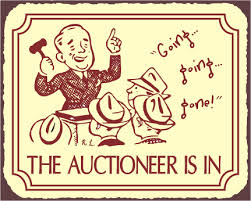
|
| Auctioneer |
Nearly a hundred people had numbers for used books, maybe a similar number for antique furniture and paintings. Obviously, one other purpose of the registration process is to create a mailing list of customers interested in various objects, possibly linked to a program which sends out flyers and announcements. Country auctions have always been a source of local entertainment, so non-buying spectators are able to come and watch if they wish. There seemed to be few if any casual sight-seers; just about everybody is a buyer or a potential buyer. Players, as they say.
Most of the customers probably set their alarm clocks for 5 AM or earlier; the auction is centrally located, but most everybody comes from a considerable distance. At 9 AM, very promptly, the auction began, and from his manner, you could tell the auctioneer was anxious to get started. The object for sale had been on display for a day, but most people arrived around 7 AM to examine the goods, which are frequently sold in lots, meaning a box full of thirty or forty books more or less on the same topic. At the stroke of nine, the auctioneer chanting began, "Do I have ten dollars, yeh, ten, ten, ten, five, five, ten, fifteen, twenty, twenty, sold for fifteen. Your number, sir?" Two assistants took down the customer number, and the lot number, and the price; one of the two recorded the transaction in a computer, the other on a list by hand. One gathers the man without a computer was on the look-out for shills, people trying to bid up to the price without getting stuck for a purchase. The auctioneer repeatedly assured the audience that no one but a real bidder was allowed to bid, you owned it, and no excuses about being confused. When he reached he hundredth sale, he stopped for a drink of water, and proudly noted the first hundred sales took thirty-seven minutes. It required four other assistants to fish out the lots next in line, holding them up for confirmation only, since inspecting them at as the distance was out of the question. After each sale, the assistant dumped the prize in the new owner's lap.

|
| Auction Paddle |
And yet entitled to wonder a little. The ordinary run of books thirty or forty years old will sell for between ten and twenty dollars. Books about golf, just about any old book about golf, "go" for about forty dollars. Children's books are about sixty dollars. And, to my great surprise, boxes or albums of old photographs go for over a hundred dollars. A lady next to me excitedly brought an album of old photos back to her seat and thumbed through them. "Are you a dealer?" Yes. "Who buys this stuff?" I don't know, they come to my store and just buy it. Like the Auctioneer, she had a feeling for what the retail price would be, made a calculation, and knew what she could afford to pay wholesale. What the stuff actually represented, why people wanted it, what was a good one and what was a bad one--these people in the trade had very little idea. But they knew very precisely what a fair price, and gradually lowers it until it sells. Fun Lots of fun. When a familiar insider makes a mistake and pays too much, the others laugh heartily at him. Why this funny system works has long been a mystery, but everyone except a socialist readily acknowledges it does work. At least it works better than any known substitute.
Although the ritual of the country auction has been essentially unchanged for the centuries, it is just another transaction system. In the past fifty years, the world economy has been transformed by computerized efficiencies in transaction systems, with vast prosperity resulting from small saving endlessly repeated. Banking and Wall Street have concentrated most of the standardized transaction, in perfectly astounding volume; lots and lots of people have become immensely rich for producing small efficiencies in high volume. Those of us who have not become immensely rich can easily identify trivial innovations which resulted in wealth, and we easily sense the unfairness of old photos worth more than books of poetry. After all, the country auction is still grossly inefficient; the seller pays the auction company 20% of the price, and the buyer pays another 10%. There's 3% for the credit card company and &% for the sales tax. Forty percent of this transaction is going to the middle man, over and over and over again. The goal is to reduce transaction costs to the level of Wall Street, considerably less than one percent, Which still lots of yachts for middlemen.
As you walk out of the country auction, it doesn't take a mathematical genius to multiply thirty percent times the number of transactions, times a guess at the average sales price. No wonder these auction people are so cheerful, so much in love with their work. But two other parties are cheerful, too. That is, the buyer and the willing seller.
Water Works, Emblem of the Past
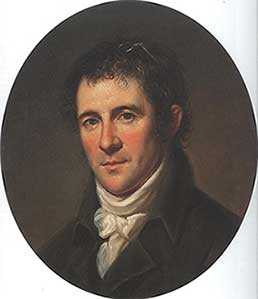
|
| Benjamin Henry Latrobe |
Philadelphia didn't really want the national capital to move to Washington DC, but the yellow fever epidemics, brought from Haiti by refugees, made it politically impossible to reverse the decision to move. We now know that Yellow Fever is transmitted by mosquitoes, but there were enough trash and pollution lying about the that it was plausible that polluted water was the cause. With no time to waste, water was piped in, through wooden pipes, from the comparatively pristine Schuylkill to a pumping station in Center Square, where City Hall now stands. Even today, no one wants a water tower in the neighborhood, so Benjamin Henry Latrobe made it look like a Roman Temple, thereby introducing classical architecture to Philadelphia, and starting quite a trend. The new system worked well enough from 1801 to 1815, when the new city outgrew it. Therefore, a new pumping system was built at the base of Faire Mount, where William Penn once planned to have a mansion, and was attached to Latrobe's wooden pipe system. In a unique and ingenious way,

|
| Latrobe Water Works |
Frederic Graff pumped Schuylkill water up to a series of reservoirs on top of Faire Mount, utilizing a water stack to maintain constant pressure. The classical architecture was continued, parks and decorative gardens were placed around it, and admirers came from around the world to marvel. Meanwhile, Latrobe's original building could now be torn down, providing room for City Hall, which was planned to be the tallest building in the world, although the French sort of cheated and put up Eiffel Tower, which in a sense really isn't a building. Meanwhile, Philadelphia and the rest of America kept growing and growing, leading to industrial plants along the Schuylkill all the way up to Pottsville, where the anthracite came from. The pure sparkling municipal water of which Philadelphia was so proud soon became a stinking sewer, and the Civil War encampments accelerated the process.

|
| Frederic Graff |
Following the lead of the Philadelphia College of Physicians, the concept of Fairmount Park emerged from clearing the banks of the river, and the Wissahickon Creek, of industry. The Philadelphia Water Works thus became the southern anchor of the largest city park in the world, including the building of Laurel Hill Cemetery, which had sanitary overtones which were embarrassing to discuss. Philadelphia led the world in adapting to this particular feature of the Industrial Revolution, and the insights of Louis Pasteur. By 1890, however, the system was again outmoded, and Philadelphia water became the butt of every joke. Between 1815 and 1840 the wooden pipes were replaced by iron ones. Robert Morris's old estate of Lemon Hill was acquired by Fairmount Park and used to construct a second reservoir on the neighboring hill. More about that second reservoir, in another blog.
Eventually, there would be more reservoirs at Belmont and Green Lane. But the city's new reputation for foul water was deserved. Deaths from typhoid fever rose to 80 per 100,000 residents before a water filtration system was installed; deaths from typhoid promptly fell to 2 per 100,000. Statistics on hepatitis were not available, but virus diseases must have been a serious hazard under primitive conditions of filtration, aeration and chlorination -- as they still are in many third-world countries, and in most southern European nations before 1950. As late as 1950 in Philadelphia, it was considered witty for a dowager to accept a drink from her hostess, saying "I'll drink absolutely anything, except Philadelphia water -- and 'Coke' ". The implication was that alcohol sterilizes water, which of course it doesn't, and also that absolutely everybody knows that Philadelphia has terrible water, whatever that means.
A reputation like that is bad for the city, making it harder to persuade workers and business to locate here, but the traditions underlying this response are quite ancient. Back in the days when water came from your own well, whole neighborhoods would move to new unspoiled areas to seek cleaner water and regions where the local privies were not yet mature. It takes quite a lot to persuade people to abandon the investment in a home or mansion as in Society Hill, and build a new one in a nearby undeveloped region. Particularly when the germ theory was not yet available to explain the issues with precision, pulling up stakes for a new neighborhood was an accepted reaction to almost any threat.

|
| Water Works Today |
However, strenuous exertions for half a century have made Philadelphia water safer, tastier, and far cheaper than bottled water. The recent trend of young people to walk about sucking a three dollar bottle of water drives the Philadelphia Water Department up to a wall. For example, 25% of bottled water comes straight from the tap. The inspection standards for public water are much stricter than for commercially bottled water, whose safety is in large part secondary to the safety of the tap water from which it is derived. True, public water is chlorinated, but then it is also fluoridated, putting legions of dentists out of business. In Philadelphia, that's the main difference justifying the rather appalling price difference, and the accumulation of plastic bottles in various trash heaps.
The recent advances in Philadelphia's water can in part be traced to Ruth Patrick, now over a hundred years old but the world's foremost expert on streams and water, and to the persistent professionalism of the Philadelphia Water Department. Perhaps, though, it may take a century of slander about water to persuade the politicians to keep their hands off the Water Department. It does take a lot of tax money to implement the third step in the process of cleaning up the water supply, which is the purification of wastewater. For centuries, the guiding principle was to obtain and maintain pure water at the source; wastewater was flushed down the sewer to go back out to the ocean. However, seven times as much water is removed from Delaware, as it flows past the city. That is, the water now recirculates through the sewage system seven times before it is turned over to residents of lower Delaware Bay. The expensive and elaborate -- but scarcely visible -- system of treating sewage in various sewage treatment centers has now resulted in returning water to Delaware in better condition of purity than it had when it came down past Bucks County.
But it costs lots of bucks, and nobody seems to notice the water. People only notice the bucks.
Tales of the Troop
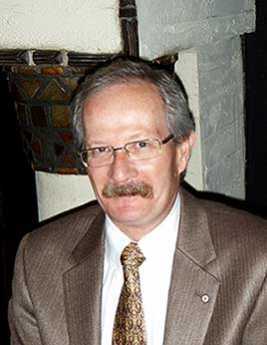 |
| Dennis Boylan |
Dennis Boylan, the former commander of the First Troop, Philadelphia City Cavalry, has been poking around in the archives up at the Armory, and was invited to tell the Right Angle Club about it. In all its history, there have only been 2500 members of the troop, but they have been a colorful lot, leaving lots of history in bits and pieces. The troop boasts that it has seen active duty in every armed conflict of America, and means to continue to fight as a unit of the Pennsylvania National Guard. However, we have lately had so many actions, the troop has had to split off units to be able to go to the Sinai Peninsula, Bosnia, Kosovo, Iraq, Afghanistan and whatever is going to come next. An eighteen month tour of active duty takes a lot out of a citizen soldier's life, but no one is complaining, and there is no fall-off in volunteers.
Although most troopers are polite and taciturn, it is probably hard to remain unaffected by association with people like A.J. Drexel Biddle, a pioneer of the bayonet and hand-to-hand fighting, much sought after for training other units of the military. Or George C.Thomas, who was a golf course architect, but also a seaplane expert, responsible for the seaplane ramps next to the Corinthian Yacht Club along Delaware. Or Rodman Wannamaker, responsible for aeronautic development, also down in the marshes where the Schuylkill joins Delaware. Robert Glendinning, who was notable for other adventures, was also an early pioneer in airplanes. As a matter of fact, Henry Watt had himself flown from Society Hill to Wall Street in a seaplane, when he was President of the New York Stock Exchange.
It's hard to believe, but a former trooper named Eadweard Muybridge distinguished himself in the art world, as a result of a bet with Leland Stopford, that a horse at a gallop reaches a point where all four feet are simultaneously off the ground. The consequence was a famous set of rapid-sequence photographs which are quite famous at the Pennsylvania Academy of Fine Arts. There are elephants, horses, people in various states of undress which remain as interesting artworks as well as scientific evidence that horses feet do indeed leave the ground. But in case anyone believes that Muybridge was some sort of sissy from the art world, there is the story that he caught his wife in an affair and shot the other man dead. As one might expect, the jury found him not guilty, on the grounds of justifiable homicide. With a name like Eadwaerd, it's probably necessary to demonstrate your manliness.
Robert Glendinning, class of 1888 at Penn, became Governor of the New York Stock Exchange, founded Chestnut Hill Hospital and the Philadelphia School for the Deaf. And Thomas Leiper makes a pretty good claim for starting the first railroad in America. It was only 2 miles long, in Swarthmore, and built because he was not permitted to extend his canal for the purpose of transporting stone from upstate quarries. The railroad developed into the Pennsylvania Railroad; Leiper's house, "Strathaven" is still an important Delaware County landmark.
 |
| Tank in Philadelphia |
And then, there's the story of the salute to the QE2. When the liner made a tour up the Delaware, a search was made for cannons to provide a proper salute, and the call came to the Troop. Well, they had a tank, and they could fit a simulator on the tank's gun. So, the tank rumbled down Broad street to do its duty. South Philadelphia responded in character, too. Instead of stopping to admire the novelty of a moving tank, the drivers just honked their horns and drove around it.
Lithuanian Law
The Right Angle Club was recently entertained by its rugby-playing, Kilimajaro-climbing member, John Wetzel, about his two-week stint teaching law students at the University of Vilnius. This ancient Lithuanian institution was founded in the 15th Century by Jesuits, and after a bumpy history of invasions and occupations has now re-established itself. It participates in Erasmus mobility, meaning it is one of 47 European universities which exchange credentials and permit students from any one of them to take courses in any other member of the association; evidently, similar mobility of faculty is also part of the concept. It sounds like a great idea, which American universities might well consider.
For reasons not entirely clear, 75% of the law students at Vilnius are female, and the whole local legal profession is similarly woman-dominated. John made several allusions to the general pulchritude of his students, which a class picture with him confirms. One striking feature of such a picture is how slim the ladies are; this is another European feature our own representatives might consider imitating. Since there are 2500 law students in a country of 3 million inhabitants, whose main industries are agricultural, balance is restored by only admitting 15% of the graduates to a passing grade on the bar examinations. It seems remarkable that studying law remains so popular under the circumstances, but it was explained that most of the graduates end up working for banks or government. Governments including our own frequently feel their laws don't apply to themselves.

|
| University of Vilnius |
If you think about it, a country which is attempting to convert from a Soviet colony to a member state of the European Community has a lot of loose ends to tie up. The title to a property is regularly clouded by the experience of confiscation by the government and then subsequently return to a free economy; if banks accept such collateral, there may well be a lot of legal work to be done to assure its security. Since the thirty-odd members of the European Community all have different legal systems in different languages, all banks and businesses which attempt to operate across borders require partners or consultants in law firms in many countries. While there is a continuous effort being made to establish some uniformity of laws in the various nations of the Community, it takes a fair amount of study just to know what the laws are and how they differ. Therefore, while a handful of lawyers are sufficient to appear in court in disputes and litigation, a great deal more legal background is required, just for businesses to know how they are expected to behave.
Since, as Justice Holmes remarked, the life of the law has not been logic, it has been experienced, it emerges that a great deal of effort must be expended to create the logic when there has been no preceding useful experience. The example is offered of American bankruptcy law, which did not exist until Robert Morris forced its creation. Morris had become an enormously wealthy man, and thus created an enormous tower of debts when his speculations failed, amounting to the then-staggering sum of $12 million of debt. They put him in debtors prison on Walnut Street, but that scarcely addressed the real problems of all those creditors tangled up in the mess. Lithuania is in a similar position, and although it has created a bankruptcy law for corporations, there is as yet no bankruptcy law covering individuals, and hence credit cards, etc. are difficult to establish.
There is a notable difference in attitudes between the eastern nations which were former members of the Soviet Union, and are intensely eager to learn more about the evolution of American law, and the more western parts of Europe, where disdain and hostility for American exceptionalism is presently dominant. A moment of reflection about this difference in a situation should make Americans more tolerant of western European problems. If the logic of law evolves out of the contemplation of experience, it may well be easier to begin without any usable experience, than to begin with centuries of experience which has to be re-examined. It must in fact be a wrenching experience, but one which has the potential to teach Americans a great many things we never had to cope with. The eventual outcome should be a healthy one, providing of course that we can keep our tempers, and acquire a little humility along the path.
Pyramid-Building, Greatly Simplified

|
| Egyptian pyramids were supposed to be built |
Everyone who went to Sunday School knows the Egyptian pyramids were supposed to be built by huge numbers of slaves, quarrying stone blocks, transporting them with only crude rollers, and setting them precisely in place under the supervision of slave-drivers with whips. The number of stones has been estimated, a reasonable time estimate made for carving a block, and modern scholars have calculated that every single person in Eqypt must have been either a slave or a slave-driver. In fact, there is a theory among British scholars that such a mobilization of the entire nation could only have been motivated by religious fanaticism, since it's so hard to imagine keeping a nation at work involuntarily in the hot sun for twenty or more years, even with whips.
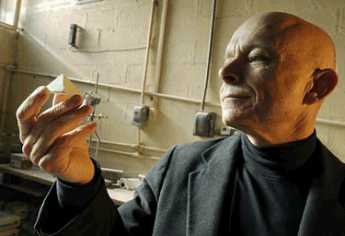
|
| Michael Barsoum |
As recently described to the Right Angle Club by Professor Michael Barsoum of the Ceramics Department of Drexel University, we probably have to revise our views. A "Eureka" moment seems to have first arrived for a French Professor named Joseph Davidovits several years ago, with the thought that perhaps the building blocks of the pyramids may have been cast in place rather than carved. Poured concrete, so to speak, rather than carved out of a quarry and pushed over the desert in some fashion and hauled up into place. Since the blocks seem precisely chiseled to fit together exactly, it has always been hard to imagine how this was done, when the Egyptians were thought to have no iron tools, only pure copper as a metal ingredient, not even bronze.

|
| Khufu Pyramid |
The insight was brilliant, although the evidence for it was weak, and it has been pretty easy to pick holes in the proposal. Poured concrete is much easier to reconcile with the remarkable leveling of the stone blocks, where the bottom level of the Khufu pyramid is the size of eight football fields but only varies from true level by one inch overall. Exploratory cuts into the sides of the pyramids reveal the component stones to vary enormously in size and shape in the interior, although the exterior surface is quite smooth. Similarly, the lateral sides of the pyramids vary from true north by only 1/15 of a degree, a remarkable achievement for stone cutting with primitive tools. Broad Street in Philadelphia supposedly runs North and South, for example, but it deviates from true north by six degrees. The pyramid builders, like the architects of ancient Beijing, must have used the Pole Star for orientation, rather than a magnetic compass.
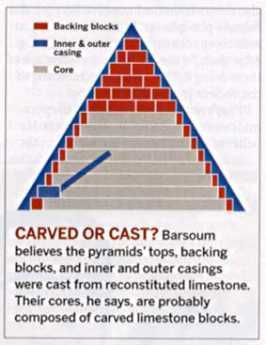
|
| Carved or Cast |
While Davidovits got this line of thinking started, Michael Barsoum has considerably advanced the proof of idea by addressing a large number of nitty-gritty questions about just how all this might have been accomplished. For example, the science of ceramics shifted the idea from the Portland Cement model to a recognition that the calcium in the cement came probably from diatomaceous earth, which is to say the crushed skeletons of diatoms on the ocean floor. Microscopic examination of the cement reveals large numbers of intact diatoms, with the cement layer surrounding the limestone aggregates. Furthermore, analysis of the stones shows that the outer shell of the pyramid was cast concrete, but the interior main mass was composed of stone rubble of various sizes and shapes. The apex of the pyramid was pure casting, probably because of the difficulty of fitting exterior and interior stones at the point. So, the Drexel team carried Davidiovits' idea from a general concept to a practical description of how the construction was probably accomplished. Carbon dating was attempted, but this technique stops being accurate for such remote time periods.
To nail down the idea that Philadelphia really explained how to build pyramids, funds are being collected for the construction of a 27-foot model pyramid in Logan Square. Let's hope the community gets behind this effort, which is both scholarly and entertaining, with an element of international competition mixed in. After all, Philadelphia is still smarting from the erection of the Eiffel Tower, six feet higher than Philadelphia City Hall, as the tallest structure in the world at that time. Let's be clear about it: the Eiffel Tower was the tallest structure in the world, while our City Hall remained the tallest building.
Mark Twain in Vienna
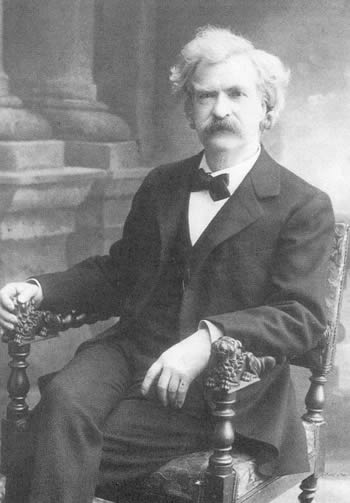
|
| Mark Twain in Vienna 1897 |
Tom Tauber, the past president of the Austro-American Society of Pennsylvania, recently entertained the Right Angle Club with a description of Mark Twain's two-year stay in Vienna, something few Americans are much aware of. Tom is President of a local aerospace firm, an industry which is also under-recognized in Philadelphia, although there is a rich and colorful history of seaplane, helicopter and aeronautical engineering in our city.
Mark Twain went broke after the Civil War<, plunging too heavily in his publishing firm, and in the development of an ill-fated type-setting machine. Somehow, his friends had learned that Twain had a fabulous following in Europe generally, but particularly in Vienna. When his daughter developed a hankering for piano lessons from a famous Viennese teacher the family packed up and moved into a many-room apartment in a hotel, out of which he ventured to give many lectures of a witty sort. The Europeans simply loved to be satirized, and during 1897-99 they flocked to hear him identify their weaknesses.
Because we had not yet discovered progressive income taxation, two years was enough time to get his finances and retirement in order, and not quite enough time for his unrestrained mockery to catch up with him. That he was pushing his luck is evident from his mixing into anti-semitism, the main public topic of turn-of-the-century Vienna. Many of the forty newspapers were owned by Viennese Jews, but sometimes the partisanship was independent of the ownership of the papers. Mark Twain's real position on the matter is indicated by his prominence in the Jewish press during the early part of his stay, and his switch to the anti-Jewish press, later on, . The central theme of the latter part of his life was that he was in financial trouble, and had to do whatever it took to get out of it. A
Glutes, Abs and Pects
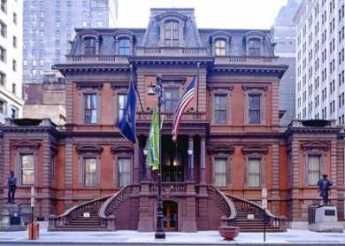
|
| Union League of Philadelphia |
Robert Matsey, the director of Executive Fitness at the Union League, recently entertained the Right Angle Club with a discussion of new trends in muscle building. Which is to say the old theory of Dynamic Tension, as featured in adolescent magazines by Charles Atlas, is being superseded by platform stabilization, a much more popular approach among senior citizens. Since a few members of the club are already in the Medicare age range, and more are approaching it with concern, the talk was greeted with great interest.
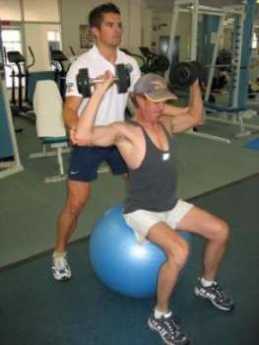
|
| Personal Trainer |
Bob Matsey has a degree in marketing, so it all comes down to this: the more powder you use in a cannon, the bigger the bang it makes. But if said cannon is sitting in a canoe, the extra gunpowder doesn't add much firepower. The new approach stabilizes the platform to magnify the cannon power, without paying so much attention to adding directly to the gunpowder. No one said that weight lifting and pushups don't bulk up your muscles; but if you want to climb stairs and lift things, it will get you farther to stabilize the pelvis and shoulder girdle than to split your seams with muscles that can't do much. Or, worse still, that will lead you to throw out a lumbar disc -- or a cervical one -- struggling to perform a simple task. All of which leads to a complicated discussion of the function of the hamstring muscles of the back of the thigh, which is mainly to overcome the inappropriate architecture we inherited when we became two-legged animals. And, as well, to overcome the tendency of a young straight back to curl up with age and inactivity, and press your nose toward the ground. One of the main causes of back pain can be traced to shortened tight hamstrings, a condition which destabilizes the platform of the pelvis.
Sitting down is the great enemy of posture and bearing; fifty years of it leads straight toward turning a former soldier into a skinny old geezer. Sitting down to a dinner table turns people into fat old geezers, deep inside which is a skinny geezer hidden by the fat.
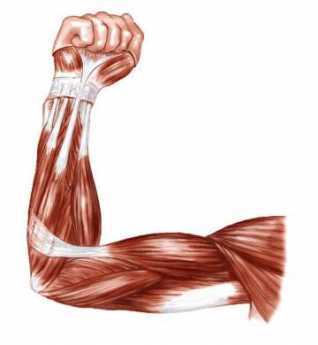
|
| Muscles |
Every medical student is puzzled to learn that most energy expended by muscles is used to lengthen, not shorten, muscles. Without getting into the biochemistry of this issue, it can be taken to explain the tendency of muscles to shorten up when under-used. And, in turn, explains why stretching works a lot better than "bodybuilding" against a resistance. It thus may help to understand why it is sometimes easier for skinny old retirees to re-build their muscles into proper balance and coordination, essentially training infantile muscles to work together in the right way. Those who have struggled to "work through the pain" may actually reinforce bad coordination and will require still more sweat on the brow to force things to work the right way all over again. For example, there are two kinds of hamstring muscles, short ones, and long ones. The short ones stabilize the pelvis, but if you whip things into obedience, you may be improperly recruiting the long hamstrings to act as stabilizers, making you in effect "uncoordinated" and awkward. RNT stands for reactive neuromuscular training, a process which amounts to improving a muscular coordination flaw by forcibly exaggerating it. The scientific basis for this jargon is a little hard to follow, but it does soon become very clear that RNT is quite uncomfortable. It makes a sort of argument for a compulsory draft into the armed forces at an early age, to beat bad muscle coordination out of the whole public at an early age, before they start sitting themselves to death in front of a computer.
A great deal of emphasis nowadays is placed on gluteal strengthening, a sort of unnatural posture training which can, unfortunately, be easily dismissed as worthless. In the spirit of defending this particular fitness training, a lady at a nearby table in a fancy restaurant was heard to exclaim to her luncheon partners, "What I mind most about growing old is that I have lost my ass!" Since obviously, this particular disability is great to be avoided, get some gluteal training, ladies.
Along the same lines, the economics of fitness centers was recently explained with considerable seriousness, but not by Robert Massey, who disassociates himself firmly. The trick, explained the outside expert, is to get people to sign up for a whole year of training when they first come in, full of enthusiasm. Since most of them will drop out of attendance after a couple of weeks, it is possible to show quite a profit running a fitness center with hardly anyone showing up.
And finally, Tom Hawes, former president of the Right Angle, rose to link this discussion with the current debate about health care reform Relating how an elderly couple in Florida went to a physician specializing in sex counseling, asked him to observe their technique and comment on it. He later told them their technique was surprisingly good, and he had no recommendations. The charge for this service was $50, readily agreed to. Nevertheless, they returned with the same request three more weeks in a row, until the doctor asked them what they expected to learn from all this. "Oh, that's not the idea. She's married, and I'm married, so we can't go home. The hotel charges $100 and you only charge $50. "
"But the beauty part is, that Medicare reimburses us $43."
Canaris and Lahousen
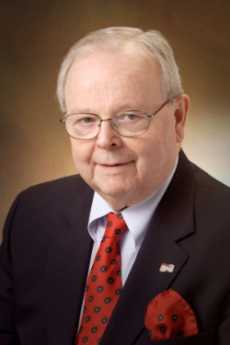
|
| Harry Carl Schaub |
Our member, Harry Carl Schaub, J.D. is the Austrian Consul-General in Philadelphia, was once a member of the American Intelligence Service and is now Of Counsel to the Montgomery, McCracken law firm. In recent years, he has taken an interest in the German Intelligence Service during World War II, and with sufficient prodding intends to write a book about the astonishing betrayal of the Nazi effort by the Chief of their Intelligence Service, Admiral Wilhelm Canaris. Canaris enlisted the top fifty officers of the Abwehr, the Intelligence Service, in his conspiracy to defeat and overthrow the Nazi leadership. All fifty -- except for one, Colonel Erwin Lahousen, Edler von Vermont -- were caught by the Nazis and executed in gruesome ways, after the plot was exposed by the failure of a bomb in Hitler's headquarters to eliminate the top Nazis. Lahousen was the first witness called by the Nuremberg Trials.
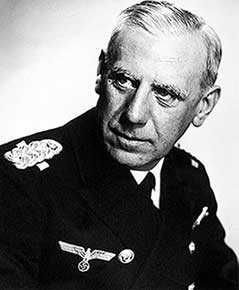
|
| Admiral Wilhelm Canaris |
Admiral Canaris, called the "most knowledgeable man in Germany" , reached his position of Intelligence Chief of the Third Reich as a result of distinguished naval service in World War I, much solidified internationally by his secret negotiations to persuade General Franco to bring the Spanish Moroccan Army to start and win the Spanish Civil War in Spain itself. (Several prominent Philadelphians were involved in these maneuvers, notably William Bullitt.) Canaris was an aristocrat and saw to it that at least the top fifty officers of the Abwehr were also aristocrats hostile to the Nazi regime, using professionalism as an excuse for the exclusion of any officer with Nazi sympathies in the service under his command. Canaris was slowly filling in the blanks in his plans, for years.
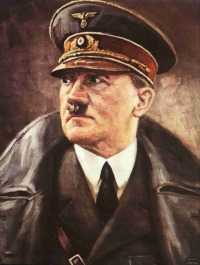
|
| Adolf Hitler |
The military aristocracy was convinced that by 1940, Germany had already won the war in Europe, with only Great Britain left standing unconquered, and an alliance with the Russians protected the Eastern Front. Canaris was close enough to Hitler to believe he was stark raving mad, and as a result of recklessness and blind ambition was about to embark on the two things which professional soldiers had been trained to fear most: a betrayal of the Russian allies and counter-invasion by them, and a land-sea invasion of England. Hitler, for no purpose they could imagine, was about to discard a complete victory in continental Europe and enter into a two-front war. Later on, Hitler committed another gross stupidity in their eyes, of declaring war on America after the Japanese bombed Pearl Harbor. This entirely unnecessary action by Hitler allowed America to follow an established principle of warfare, which is to attack the strongest of your enemies first. Added to what they saw as appalling blunders of getting into a two-front war while stirring up civilian disloyalty with their Jewish, Gypsy and homosexual extermination campaigns, the man they could personally see was mentally unstable was about to convert total German victory into total German defeat. Some of these things might prove to be successful, but sooner or later this madman was going to lead Germany into a catastrophic defeat, so he must be removed before that could happen. While it still remains almost unbelievable that such high-placed officers could risk their lives to betray their own leader, their analysis was absolutely accurate, and correctly predicted the decades of devastation Germany would endure if Hitler could not be overthrown.
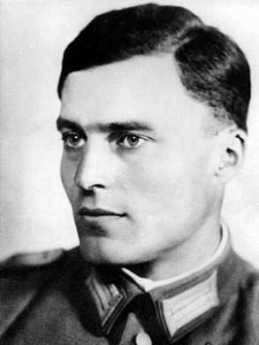
|
| Claus Schenk Graf von Stauffenberg |
And they were probably quite accurate in predicting their own punishments if they failed. Lahousen escaped because he had been assigned to a combat division and was lying severely wounded in a hospital before von Stauffenberg's bomb failed to go off properly in Hitler's staff room. The Gestapo rounded up every other member of the fifty conspirators and tortured them to death, mostly by impaling them on meat hooks. No doubt, they also exterminated a great many innocents, just to be sure they did not miss any conspirators. Canaris himself was strangled to death four times, by the process of reviving him just before he died, and then strangling him again.
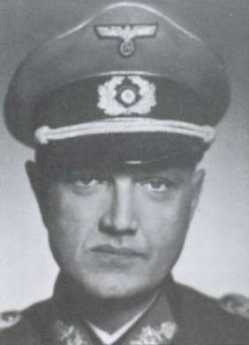
|
| Erwin von Lahousen |
And, indeed, Lahousen was apparently even mistreated as a prisoner by the British. During the war, one of Lahousen's projects was to stir up the Irish Republican Army in Great Britain, and indeed the guerrilla warfare between the IRA and the Protestant section of Northern Ireland lasted more than twenty years after the end of the war. The Brits were not amused.
Children's Scholarship Fund (1)

|
| Children's Scholarship Fund of Philadelphia |
Ida Lipman recently visited the Right Angle Club, to acquaint members with the nature of the club's new charity, the Children's Scholarship Fund of Philadelphia. This fund could be seen as a response to the rising realization that the nation's leading social problem is fast becoming one of upgrading the educational strength of the current generation of poor people, who face hopeless odds competing for unskilled jobs against a vastly larger population of foreign poor people in a globalized economy. Our poor people can never hope to rise out of poverty by taking jobs that foreign competitors are willing to perform at even lower wages. And while everyone hopes our poor people can take on better-paying jobs, it requires better education to do it. Ultimately, the question for America is whether to place the emphasis on better teaching or better learning, and the two are not quite the same thing.
The educational problem of motivating children to higher attainments than their parents is a difficult social task in both urban and rural districts, but self-defeating peer pressures to hold down their classmates somehow seems a stronger force in the urban settings. In both environments, of course, the educational attainments of both the parents and the teachers have been aimed at a lower level than the task requires. It somehow proves unrealistic to shift expectations as rapidly as we need to, and part of the present problem is that the education industry has become demoralized by repeated defeats. Consequently, we are certainly lucky that philanthropic donors have been willing to support some radical experiments in the whole educational experience, including students, teachers and parents.
Thus, the Children's Scholarship Fund has been willing to dispense several thousand scholarships to private schools in the Philadelphia region, purely by lottery, without regard to the traditional guidepost of student merit. This policy would probably be disruptive if scholarships were universally available, undermining the spirit of meritocracy which is so central to our educational system. But since we are only partially addressing the failures of a system of universal free public education, a stronger argument can be made that changing the culture occasionally requires that we set aside the traditional incentive of rewarding the behavior we seek. The hope is that a demonstration project with such a radical change will set other motives into motion. Resources are limited; it is recognized that among the ninety percent of students who fail to receive the scholarship by lottery, there will be many who are more talented than the few who are lucky enough to get an award. The point is easily overlooked however that scholarship students must apply for this lottery, and be supported by partial financial assistance from their parents. These parents must sincerely want to raise the educational goals of their children, and convey that motivation to the kids in whatever way they are able to convey it. The pressure of less lucky playmates and neighbors to hold them back, it is hoped, will be lessened by the simple recognition that a lottery gives everyone an equal chance, provided only that they step forward and pledge themselves to try to succeed.

|
| John Walton of the Wal-Mart family |
It's a bold and imaginative approach, a highly counter-intuitive one. John Walton of the Wal-Mart family matches the contributions of other donors at fifty cents on the dollar through his family foundations, which was jointly founded with Ted Forstmann of the Wall Street firm. Many longitudinal studies will eventually show how much this bold and charitable venture really helps the students and the community; since it is private money in use, criticism should be held back until the results begin to be apparent. To whatever degree and in whatever way the scholarship fund is a success, the public must be willing to praise both its spirit of generosity, and its willingness to take a chance. Let's all mark this down in our notebooks, to see how it all turns out in ten or so years.
Line Dividing East from West Jersey
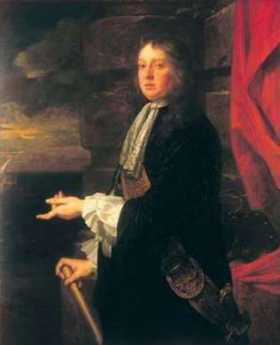
|
| William Penn |
At this point William Penn entered the picture as one of three Quaker trustees for Byllinge, who had gambling debts. A tenth of this share was given to John Fenwick, the 1675 settler of Salem, to settle his part of the disputes with Byllinge; the rest of it constituted what was to become the oldest American stockholder corporation, The Proprietors of West Jersey. The arrangement up to this point was firmly settled for the southern half of New Jersey by a Quintipartite Deed of July 12, 1676, , signed by the three Quaker trustees plus Byllinge and Fenwick. Aside from establishing the Proprietorship, the main point of this deed was the separation of West Jersey from East Jersey (the Carteret part) by a North-South line which still persists as the upper border of Burlington County. The right to govern this land was fully restored in 1680 by a Confirmatory Grant from James, probably after considerable lobbying in London by William Penn.
Presumably in pursuit of this final confirmation, Penn had negotiated a hundred-page agreement with prospective settlers which outlined his plans for governing, called the Concessions and Agreements of March 14, 1677, . Although its original purpose was mainly a real estate marketing tool, this landmark document seems not only to have persuaded the Duke of York but so shaped the thinking of the English colonies that many of its features are readily recognized in the American Constitution of 1787.
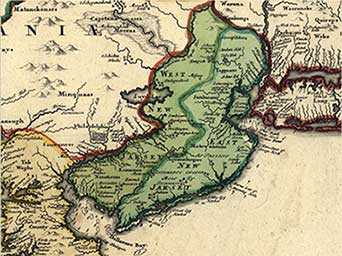
|
| The line dividing West and East NJ |
The land mass between the North and South Rivers (Hudson and Delaware) only came completely and legally into the hands of Quakers in 1681. At that time Carteret's widow, Lady Elizabeth, sold the northern half (East Jersey) to twelve Quaker proprietors, while the southern half (West Jersey) was already held by thirty-two other Quaker proprietors under the effective leadership of William Penn. It is somewhat uncertain who orchestrated this final consolidation, but there is a strong presumption that it was Penn. Since the main purpose of these business proprietorships was to sell land to immigrants, it was vital to minimize land disputes with accurate records and accurate surveying. With a history behind them of fifteen years of bickering, everybody concerned was surely ready for some peaceful organization. Both groups of proprietors, East and West, found it useful to delegate authority to a council of nine executive proprietors, whose main agent under the circumstances was logically the Surveyor General. For the next three hundred years, the surveyor generals were the men running things in New Jersey. The right of the Proprietors to govern was revoked by Queen Anne in 1702, but their land rights remain undisturbed to the present day, notwithstanding the intervening transfer of national power to the United States of America in 1776-83. Underneath all of this hustling and arranging, with exquisite attention to details, seems to be found the hand of William Penn. Almost immediately after New Jersey was packaged and delivered, King Charles paid off his family debt by turning over the far larger combined land mass of Pennsylvania and Delaware to William Penn, urging him to make himself a vassal king in the process. The Quaker instantly declined such a thing, but the power continues to reside in the final Royal Charter. It's only a conjecture, but it might help explain the strange acquaintance between a dissolute king and an abstemious Quaker to notice that the New Jersey tour de force astoundingly demonstrates how Penn was a man who really could be trusted to get complicated things done with dispatch.
Today, for practical purposes it all amounts to a company named Taylor, Wiseman, and Taylor; but we are getting a little ahead of ourselves. To go back to 1684 a surveyed line was clearly needed between the two proprietorships, as declared by the following resolution:
"Award we do hereby declare, that [the line] shall run from ye north side of ye mouth or Inlet of ye beach of little Egg Harbor north northwest and fifty minutes more westerly according to natural position and not according to ye magnet whose variation is nine degrees westward."
To clarify those quaint words, the survey was not to make the mistake made in the layout of Philadelphia, whose streets had intended to be true north and south but by using Magnetic North are actually twelve degrees off from that. Another important point is probably unclear to modern readers, who know the town of Egg Harbor on the mainland of Barnegat Bay but are largely unaware that the "beach of Egg Harbor" was what we now call Long Beach Island, on the east side of Barnegat Bay. The southern anchor of The Line was in what we now call Beach Haven, on the north side of the inlet, although beach erosion has put the southern anchor about two miles out to sea, locating a temporary marker in Beach Haven. Hardly anyone seems to be aware of it, but reread the sentence and observe the meaning is actually quite clear. The intent of the northern end of The Line (? the Delaware Water Gap ?) is buried in the obscurity of compass markings, but comes out slightly above Trenton on the Delaware River, extending beyond the river into Pennsylvania until it reached the river again in a crook on the far side of the Delaware Water Gap. Word of mouth has it that William Penn wanted to have both sides of the river although this triangle of Pennsylvania was eventually surrendered. It seems fair to say, the line was roughly intended to run from the Beach Haven ocean inlet to the Delaware Water Gap.
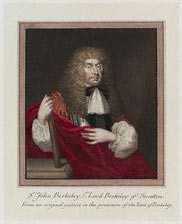
|
| John, Lord Berkeley |
For its time, the survey of The Line was also a significant engineering achievement. The general plan was to lay out the course of the line in the wilderness until it hit a big boulder or anything else that was large and heavy. This became a marker along a line of 150 markers which could be used for local surveys and boundaries. After several less accurate attempts, the West/East line was surveyed by John Lawrence in 1743 and stands as the Official Province Division Line. A few years ago, a group of volunteers tried to locate all of the original markers and found 55 of them. The historical project took ten years.
All of the deeds of property in the State of New Jersey still depend on the original survey and the meticulous notes kept by the Surveyors General of these two Quaker organizations, without whose private records every title to every property would be clouded. With the passage of time, and especially the warfare of the Revolution, other copies of the surveys have disappeared. So, without the need to get ugly about it, these soft-spoken courteous folks retain a form of power it would be hard to match with sticks and stones, guns, threats or legalisms -- the only surviving record of everyone's title to his land. There is little reason to inquire further why these Proprietorships durably survived the revolution which overthrew King George III, and why no one has seen fit to enter the serious challenge to their claim of owning the whole state except for what they had already specifically sold.
Let's go back to a point made earlier. In all the complexities of the English Royal Court and uncertainties of uncharted wilderness, how did a little band of Quakers find themselves with uncontested ownership of a whole American colony? Some of the chaos of the age probably helped. King Charles unleashed his brother's armies in 1664. Also in 1664, Parliament passed the Second Conventicle Act, which provided that not more than five persons were permitted to worship together otherwise than according to the established ritual of the Anglican Church of England. This act might be described as an improvement on the First Conventicle Act of Queen Elizabeth, which provided that no one at all could so worship. However, this prohibition was so extreme it was ignored, whereas the Second Conventicle probably had some popular support. It thus can be imagined why Quakers were suddenly interested in leaving England, and not hard to understand how young William Penn was propelled into leadership by successfully overturning that Act in the Haymarket Case. Penn was both the defendant in the case and the defense lawyer, inventing the common law principle of jury nullification that has so confounded tyranny ever since. To go on with events current at the time, the Great Plague took place in 1665, making London an undesirable place for anybody to live. And finally, George Fox, the founder of Quakerism, took a journey to the new world in 1672, noting that the place now called Burlington, New Jersey was "a bravest country". Taken altogether, it is not hard to suspect this group of fairly wealthy, fairly well-educated people developed a collective resolve to buy up the pieces, assemble the parcel, and go away to live on it. Their organization into monthly local meetings, quarterly regional meetings, and annual national meetings was surely great assistance. From what we know of the broader vision of William Penn, it is fair to speculate his enthusiasm for this communications network first suggested by George Fox, or at least he's having a pretty quick recognition how it would assist the emigration venture.

|
| George Carteret |
George Carteret's widow was the last to sell out her land parcel to the East Jersey Proprietors, presumably drawn from the 1400 immigrants who had arrived in Burlington on five or six ships between 1678 and 1681. In particular, the ship Kent sailed from the Thames in 1677, bearing 230 Quakers, half from Yorkshire, the other half from London settling further south in West Jersey. Before that, Lord Berkeley had sold his half for a thousand pounds to John Fenwick and Edward Billynge, who arrived in Salem on the ship Griffin in 1674. These two soon fell out, with Fenwick taking a tenth of the land and settling around Salem. Billynge got into unspecified difficulties, probably gambling, and turned his property over to his three main creditors, William Penn, Gawen Lawrie, and Nicholas Lucas, who assembled the Proprietorship of West Jersey. Penn's remarkable talent for leadership again emerged in his statement of "Concessions and Agreements" with the Indians and new inhabitants. In another place, we discuss the reasons for thinking this document created the effective basis of the U.S. Constitution. By infusing it with the unspoken word of compromise, Penn created the main model explaining why the ratification of the Constitution remains the only time in history when thirteen independent nations voluntarily gave up sovereignty for the purpose of creating a larger vision -- which then held together for two centuries. But the voluntary union of East and West Jersey certainly has a claim to being earlier, although its claim to sovereignty is weaker.
Perhaps so, but since their interest in power was weaker, their achievement in peaceful negotiation with a secretly Catholic King was surely much greater. If some small group of religious dissidents should today emerge as having quietly and systematically bought up an entire state, however legally, the word conspiracy would be on every tongue. In this case, however, the reaction was peaceful consensus.
George Washington's Cherry Tree, Revisited
|
||
| George Washington Chopping the Cherry Tree |
Parson Weems, it seems, was a mercenary type who made up stories because he thought they would sell. Someone should explore the history of this anti-Weems debunking campaign for us, because it has distracted history from what may be a far more important truth about the founding, and the founder, of our country.
The address President Washington sent to his countrymen, published September 19, 1796, will apparently be forever referred to as his Farewell Address, and it is true that one of the important points he was making was the President should have only two terms of office, adding in his particular case the determination not to die while in office and create undesirable precedents for Presidential succession. It is also sometimes stressed that Washington cautioned the nation against all foreign entanglements, although likely he had in mind the particular conflicted loyalty at the time between England which we strongly resembled, and France to whom we owed a debt of gratitude for our independence. Surely he was telling the nation to watch out for its precarious independence, even at the price of disappointing old friends, and not really attempting to look centuries ahead in foreign relations. The point about a third term was a pretty firm one; Washington's greatest achievement in the eyes of the world was to renounce all resemblance to monarchy, which he could have had for the asking.
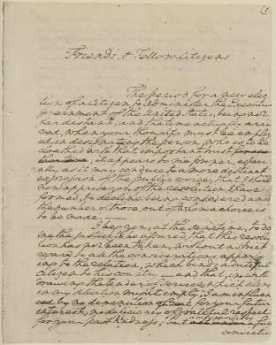
|
| Farewell Address for George Washington |
Much deeper meaning for the address is suggested when you search, let's say with Google, for the origins of the speech's repeated maxim, Honesty is the best policy. It sounds like the sort of thing Ben Franklin would put in his Almanac, but didn't. There are even times in Franklin's life when it might be questioned whether he really believed honesty was always the best choice for every situation, and Franklin's true belief might possibly have been closer to advising that you should strive to avoid getting caught misleading people. The opinion that honesty is the best policy sounds as if it might come from Shakespeare, or Cervante's Don Quixote; something pretty close can be found in both places. It might be much older than that; the phrase and a detailed examination of its merits can be found in the works of Quintilian, 69 AD. George Washington was unlikely to have read any classical Roman essays, but James Madison the favorite student of John Witherspoon at Princeton might well have been familiar with Quintilian. But these stray remarks about honesty are merely scatterings over fifteen centuries, mostly throw-away lines. It is only in the last decades of the Eighteenth Century that the little maxim is found peppered in the speeches of many people, beginning to use it as a cliche to adorn some other point of emphasis.
 It is our true policy to steer clear of permanent alliances with any portion of the foreign world; so far, I mean, as we are now at liberty to do it; for let me not be understood as capable of patronizing infidelity to existing engagements. I hold the maxim no less applicable to public than to private affairs, that honesty is always the best policy. I repeat it, therefore, let those engagements be observed in their genuine sense. But, in my opinion, it is unnecessary and would be unwise to extend them. 
|
The point begins to catch the imagination that perhaps this flowering of a maxim can be traced to Washington's Farewell Address. It's unlikely that George Washington actually coined the phrase that honesty was the best policy, any more than Franklin Roosevelt coined the motto that all we have to fear is fear itself, or John Kennedy originated the happy phrase that we should ask not what our country can do for us, etc. Our more sophisticated views of Presidential rhetoric are now quite broad enough to accept the existence of ghostwriters and wordsmiths. It is current practice to agree that credit for originating a phrase adheres rightly to the person symbolized later when the phrase enters common parlance. To think otherwise is to become entangled in bickering about who wrote Shakespeare's plays, or who really wrote the various books of the Bible.
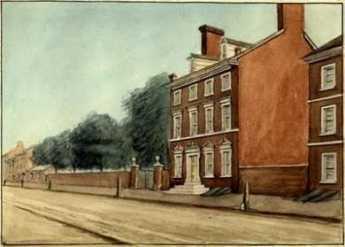
|
| President's House Philadelphia |
There is, however, historical importance to the speech-writer question in Washington's case. We are told that Washington had asked James Madison to draw up a speech for the occasion of his declining to accept a second term of office in 1792, but the whole matter was reconsidered when various advisors finally persuaded the President that the country needed him at the helm for more than four years. The speech was therefore set aside but revised and re-issued four years later. By this time, however, Washington and Madison had experienced their fateful falling-out, and therefore Madison's arch-enemy Alexander Hamilton did the re-writing. That honesty is the best policy should survive as a centerpiece in an address co-edited by such bitter philosophical enemies, plus some passing reflection on the personalities of the three men, should suffice to dispel most doubt that the sentiment was Washington's and that it must have been held very intensely by him. Madison may well have planted it, and he might very well have got it in turn from Cervantes or Quintilian. David Hume of Scotland might be an even likelier source. But overall it is hard to let go of the idea that Washington seized on it as a summary of something he fiercely believed.
There are differing degrees of and situations for honesty, of course; surely the most trivial is the sort of honesty Parson Weems was imagining in the little lad who would become our greatest leader. It really is not necessary to believe the courage to risk a whipping by a schoolboy is a core value which evolves into the broad economic vision for a nation. The legal profession, for example, may even overvalue absolute precision of wording, sometimes tolerating exquisite accuracy which artfully avoids full disclosure, caveat emptor. The military academies come closer to Washington's meaning by stressing to their graduates that what matters is not what is said, but what is communicated. At the time of the Farewell letter, what agitated Washington most was political partisanship -- political parties -- and overzealous effort to defeat the opinions of honest opponents rather than strive for a resolution of problems by bargain and compromise. In his youth, Washington was a surveyor, deeply impressed by the advantages of getting things straight the first time. Washington was to lose the argument over political parties, but while this defeat was among his greatest disappointments, his resistance still shines like a beacon.
It is hard to discern whether Washington had the depth of economic insight to emphasize the feature of honesty is the best policy which has the greatest importance to the Twenty-first Century. However, it is possible he did, because he was speaking in the midst of Quaker Philadelphia, having centered most of his public life there. Puritan Boston deeply believed that God had commanded honesty in His followers, honesty for its own sake, and the sake of the honest person's soul. But the wealth of Boston was overshadowed by thriving Eighteenth-century Quaker Philadelphia. Honesty to a Quaker was, of course, a good thing in itself, but experience showed that strict honesty in commercial dealings, and friendliness in all dealings, was very good for business. And conversely, the example of success on all sides encourages others to be honest and friendly when perhaps it was not their first inclination; honesty is catching. John Adams was scornful of those who do the right thing for the wrong reason, but this viewpoint gets ignored in the Twenty-first century. What is important for the third world to grasp is not intuitively obvious; they see abundant examples of getting rich at the expense of others, so much so that the third world and much of our own is willing to believe that if you have prospered, you must have stolen. If the third world cannot grasp the higher truth, we despair of ever getting along with them. Indeed, we may need to worry about skeptics increasing in our own midst. If Washington ever wavered, however, no one has told us of it.
Only Three Things Wrong With American Healthcare

|
| American Healthcare |
Although Congress is offering several thousand pages of proposals for healthcare "reform", none of them even mentions the three main difficulties, to say nothing of fixing them. Let's be terse about this:
1. Health insurance is fine, but if you make it universal, there is no impartial way to determine fair prices. Somebody must haggle with the vendor in order to introduce the issue of what is the service worth? The customer doesn't care what it costs to make, or whether the vendors are being paid fairly. If everyone is insured, no one cares what it costs. Not only do all costs rise, but they rise without coordination, without a sense of what each component is worth, relative to alternatives.
2. Employer-based insurance is fine, but it ends when employment ends. You just can't stretch employment-based insurance because you can't stretch employment.
3. State Medicaid programs are fine, but just about all fifty states are going broke trying to pay for it. Extending it to more people by raising the income limits just makes things worse. Items 2. and 3. are related. Trying to do both -- expand Medicaid as employment shrinks -- during a recession is incomprehensible. Item 1. (price confusion) gets drawn into this because the States try to pay less than it costs, hoping to shift the deficiency through hospital cost-shifting, utterly confounding the information which prices provide. The doctors have no way to tell which is the cheapest approach to a problem, so they don't try. Without control over prices, we can only control volume.
That's really all there is to this mess. Not one word of the current legislation even mentions these problems, so of course the legislation blunders. Even a child can see that compulsory expansion of benefits to universal coverage will fail if you can't pay for what you already have. No one will make sacrifices for a new system if the sacrifices seem futile. They are futile, so leave me alone.
The current administration has been compared with bank robbers who see they are trapped and decide to shoot their way out. Let's see them try to shoot their way past the first Tuesday after the first Monday in November.
Re-Doing Dilworth Plaza
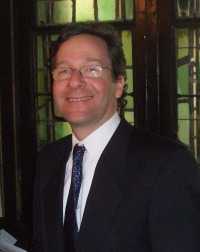 |
| Richard Maimon |
Richard Maimon recently visited the Right Angle Club to tell us all about the architectural plans afoot to consolidate the underground transportation network underneath City Hall, change the patterns of foot traffic, open up the views, and draw the visitors to the expanded convention center into the city itself. All of this is to be accomplished by paving over Dilworth Plaza and planting it with grass, along with an extensive fountain installation which can be used for winter ice skating. In the course of creating an entrance hub for Septa, the Broad Street and Market subways, walkways are rearranged and -- it is hoped -- the foot traffic around City Hall will shift around to make it a real city center. It's a very expensive dream because of all the overlapping transportation tunnels hidden under the largest and heaviest stone building in America, leading to a great deal of expensive construction work that doesn't show.
 |
| interior view of concourse north_ |
Dilworth Plaza is currently almost completely deserted, so its conversion will not be much mourned. However, the mixture of contemporary transportation entrances with the neo-classical architectural style of City Hall will probably meet resistance, and there is concern that excessive foot traffic could convert a grassy park into a mud puddle, while a large open-air lake could become a public rest-room for the homeless if the designers aren't careful. To some extent, the public forces to be resisted in the design will be self-policing if the anticipated foot traffic is at the anticipated level, but overwhelmed if the project is too successful, or left to deteriorate if it fails to succeed. And it's all too expensive to do twice; the designers have to get it right the first time.
 |
| Section Pavilions |
So, it all comes down to money. Construction costs are less during a recession, but raising money is easier during a booming economy. High hopes are raised for a Democratic governor to be able to persuade a Democratic president to divert stimulus money our way. High hopes are raised for a former Mayor's ability to divert state funds to our part of the state. In other words, it all depends on Governor Rendell, now that Senator Specter has navigated himself off the Appropriations Chairmanship. In our system of government, public works projects have to be placed somewhere, so the best system is to rotate the goodies in an informal way. This rotation, in turn, depends on a geographical rotation of the top political officers, since they can claim that it is "Philadelphia's turn". So, the grim reality is that only two Philadelphia mayors in history have become governors of the state, with the rather bitter result that Philadelphia has been neglected in the siting of the available public projects for a very long time. Digby Baltzell long preached that it was our own fault, for being too non-aggressive. But most of the rest of us, particularly those who have wrangled with the upstate legislature, blame the situation on narrow-minded opposition from those who have worked the gerrymandering game for a couple of centuries.
Harry C. Bishop 1921-2009
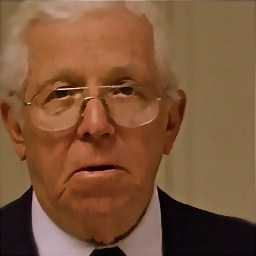
|
| Harry C. Bishop |
Harry C. Bishop, M.D., a pediatric surgeon known throughout the medical world, died suddenly of heart failure at his home in Haverford on May 9, 2009, at the age of 88. He was one of the originators of the specialty of pediatric surgery and pioneered many techniques for operating on newborns and very small children.
After graduating from Dartmouth in 1943 and thereafter from the Harvard Medical School and serving as a major in the U.S. Army Medical Corps in Wyoming and Kansas, he completed several surgical residencies. In 1954 he came to Philadelphia from Boston's Children's Hospital to join C. Everett Koop, M.D. at Philadelphia Children's Hospital. Over the years, Dr. Koop and Harry partnered in the development of new techniques to correct potentially fatal abnormalities in newborns. In retrospect, Harry estimated that he had operated on over 9,000 children. He was Professor of Surgery at the University of Pennsylvania and the author of 78 publications. His reputation was worldwide, and he lectured in many countries, being elected to the British Pediatric Society and the German Pediatric Society.
After retirement, Harry joined the Right Angle Club and served on the Board of Control until 2008. He greatly enjoyed the Friday luncheons at the Racquet Club as well as the special holiday events throughout the year at the Union League, the Downtown Club, the Corinthian Yacht Club, and the trip to the battleship New Jersey, among others. Having spent his professional career engrossed in medicine, he particularly appreciated the insights he gained from the varied topics of discussion stimulated by the speakers and subsequently in conversations with fellow members of diverse backgrounds and activities.
Harry was in every sense a family man, devoted to his wife, the former Deborah Dilworth Newbold, and liked nothing better than spending time with his daughter, two sons, brother, and sister, often in boats or ships.
Sailing was one of Harry's greatest pleasures. As long as he was on the water, he was happy to be on all kinds of vessels, yachts or commercial cruise ships. He went on many cruises and was the joint owner of yachts in the Chesapeake and the Caribbean, the Caribbean yacht appropriately christened "Heaven." The cool and calm demeanor that he was known for in the operating room was reflected in his capacity as Captain no matter what the weather, which endeared him to his many friends who served as crew.
A kind and thoughtful man of many interests, Harry was always engaged in one or more continuing "projects," from fashioning boat models to repairing screens at my summer camp in Maine. He was a skilled electrician as well as a plumber, as some of us have gratefully learned in emergencies of sorts at one time or another.
All of us who have had the rewarding pleasure of Harry's company will greatly miss his sense of humor and friendly interest in the companionship of friends in the Right Angle Club.
Dick Palmer
Fred Etherington
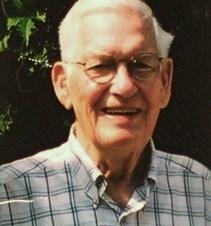
|
| Fred Etherington |
Thoughts about Fred Etherington Since my induction into The Right Angle Club in 1997, Fred Etherington was always most supportive of me and through the years we became very good friends, in spite of the difference in our ages. In summer 2001, I gave a talk to the Club about 3 cities in Germany and Fred then recommended me for the honored 4 year Board progression, resulting in becoming President of the Club in 2004. During this time, Fred and his brother, Burt, were the Club's historians and we further bonded at the monthly Board of Control meetings. Also during this time, we would see Fred and his family each summer in Nantucket. I remember riding my bike down India Street and passing Fred's rental house every day. When he had been more mobile, he and his family (his wife, Frances, and daughters Susan and Laurie) would come to our place for our cocktail parties. He also invited us for cocktails in his garden. Not being a big drinker himself, he still made a special effort to have a bottle of wine and a pint of gin for us sinners when we went to his home. I remember his great WW II stories and his adventures in Iwo Jima. We missed seeing him the last couple of years in Nantucket, but Julie and I would drop in to see him and Frances at Beaumont whenever we could. Although he was restricted to bed, he was always alert and very positive in his life views. To sum it up, I want to quote something our Racquet Club waitress, Rosie, said to me later on the day of his memorial service. She said to me: "He was always such a gentleman, and I loved helping put on his Club pin". Fred and Burt, both proud Princetonians, were our two special Life Members and were such a big part of what made the Right Angle Club something very special and enduring. Fred had joined the Club in 1950, he was our President in 1958, and his memory lingers on for those who were fortunate enough to have known him over the many years he graced us with his kind wisdom and joyful presence.
Robert Bryan
Past President 2004
Printed Books v. Websites
Since this book was written as a web site, then printed as a website from the book, the reader is invited to take a look at both forms of communication, and judge the advantages both ways. On the front cover is printed the web address of the whole book, and what you read here in book form will flow seamlessly forth if you enter the address ("URL") in the box provided on every browser.
PAGINATION. So that's one difference already. The book comes out in single pages, while the website scrolls down the pages without stopping for individual page breaks. Mostly, that doesn't make any difference to the reader, but if pagination is desired, the Adobe company provides a way of converting into pages in a format they describe as ".pdf format", and then provides Adobe reader as a program to read such paginated copy. Depending on the version, it is possible to make notations on the pages and send them onward to others, thus enabling a conference mode for committees and editors, etc. Extra-charge features include the ability to add material, only, thus leaving a permanent trail for legal purposes. If you press the "print" button on this particular website, you will be offered the options of converting the material to .pdf format, or others depending on your computer, and printing from the .pdf on your computer's printer. Home printing is thus a two-step process.
LINKS (footnotes). If you look at the screen version of this book on your home computer, you will find many passages within sentences appear in blue type. This is a signal you are looking at a link, and links are not exclusively confined to blue color. You can detect linking by running the computer cursor over the screen, with the effect that other passages "light up" and change color in some way, a signal that quickly double-clicking on that spot will be taken as an order to open up another site on the web. In effect, you are able to look at footnotes which display the entire reference, meanwhile providing the ability to keep on linking in other directions if the footnote provides footnotes of itself.
LINKS (related topics). In the website but not the printed version, pages which seem to relate to the same topic are grouped together in the margins, for browsing purposes. We have provided these suggested relationships within the 2500 pages of the site; to go outside the site, the reader will have to go to a Search engine, such as Google or Yahoo, but that ability is part of almost every browser.
VIDEOS. At several pages in this book, an image includes an arrow within a circle. This is the indicator which YouTube employs, and is rapidly becoming an industry standard. If you are looking at the page on a computer screen, click on the arrow to cause the downloading of an audio-visual platform, and in a moment the video will appear. If your computer does not have iTunes or similar, it may be necessary to download a copy before this feature becomes operative.
MAPS and SATELLITE VIEWS. Like the YouTube features, it will be necessary first to download a copy of Google Earth before proceeding. If Google Earth is resident, you can click the small button on the first page of the website and be taken on a guided tour. Just about every page on this website is labeled with its GPS markings, so you can read articles about topics which are geographically located near the one you started with.
Roaming around these features with this book as a starting point, you can quickly gather a general idea of the power of the computer and surmise how much more power is going to be available in a year or two. Too complicated? Naw, just a little complicated. The thing to worry about is how addictive it tends to be.
| Posted by: cheapoair | Feb 13, 2012 9:46 AM |
where is it situated?
| Posted by: [none] | Feb 1, 2010 2:57 PM |
43 Blogs
Touring Bhutan
 Touring Bhutan is strenuous, starting with twelve time zones of jet lag and ending with big mountains. But it's modernizing fast, so hurry up if you want cute and rancid butter tea.
Touring Bhutan is strenuous, starting with twelve time zones of jet lag and ending with big mountains. But it's modernizing fast, so hurry up if you want cute and rancid butter tea.
Gross National Happiness In Bhutan
 In Bhutan, Buddhists rule, and the government responds to modernization with GNH or Gross Domestic Happiness. Pause a moment, ye strivers and cravers, and think about this. Just because these guys wear funny clothes, doesn't mean they are from Hicksville.
In Bhutan, Buddhists rule, and the government responds to modernization with GNH or Gross Domestic Happiness. Pause a moment, ye strivers and cravers, and think about this. Just because these guys wear funny clothes, doesn't mean they are from Hicksville.
Field Marshal William Joseph Slim, 1st Viscount, Order of the Garter
 the rises of Bill Slim from humble beginnings to the highest honors Great Britain can bestow, may seem natural enough to Americans but raises reflections about the origins of British world rule.
the rises of Bill Slim from humble beginnings to the highest honors Great Britain can bestow, may seem natural enough to Americans but raises reflections about the origins of British world rule.
Philadelphia City-County Consolidation of 1854
 Prior to 1854, Philadelphia City was one of twenty-nine political entities within Philadelphia County. After that, it became one big city without suburbs. Growth pressure now reverses toward suburbs without a city. Political boundaries should thus shift inwardly.
Prior to 1854, Philadelphia City was one of twenty-nine political entities within Philadelphia County. After that, it became one big city without suburbs. Growth pressure now reverses toward suburbs without a city. Political boundaries should thus shift inwardly.
Cira Centre II - (?)
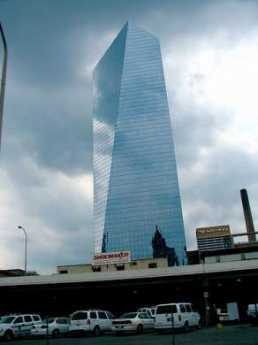 Brief description of work contemplated for the present underused site near the old 30th street post office building and area.
Brief description of work contemplated for the present underused site near the old 30th street post office building and area.
Phillycarshare
 Those little red cars running around Philadelphia are for rent, by the hour.
Those little red cars running around Philadelphia are for rent, by the hour.
Philadelphia City Controller
 A City Controller is expected to criticize the city's administration. Alan Butkovitz does his duty.
A City Controller is expected to criticize the city's administration. Alan Butkovitz does his duty.
Second Opinion: Dick Watson
 Although all major cities are facing budget crunches in today's economy, Philadelphia's problems go beyond that.
Although all major cities are facing budget crunches in today's economy, Philadelphia's problems go beyond that.
Taking Care of Our Veterans
 With programs to treat most any service-related affliction, the Philadelphia offices of the Department of Veteran's Affairs is a busy center for our freedom fighters.
With programs to treat most any service-related affliction, the Philadelphia offices of the Department of Veteran's Affairs is a busy center for our freedom fighters.
An Under-used Veterans Benefit
 A benefit which most any veteran can take advantage of seems to be little-known and consequently not many vets are taking advantage of it. It's called Aid and Attendance and can help defray the expenses of assisted living.
A benefit which most any veteran can take advantage of seems to be little-known and consequently not many vets are taking advantage of it. It's called Aid and Attendance and can help defray the expenses of assisted living.
What To Do If You Have a Heart Attack
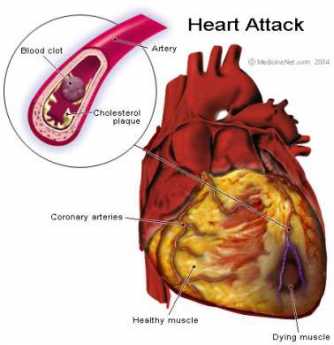 In May, I had a coronary occlusion, and a fast trip to the Pennsylvania Hospital. Cardiac catheterization opened the artery with a stent before there was time for infarction.
In May, I had a coronary occlusion, and a fast trip to the Pennsylvania Hospital. Cardiac catheterization opened the artery with a stent before there was time for infarction.
Will Power
A small group of men get together twelve times a year in Philadelphia to read and discuss the works of William Shakespeare. Phil Wagner, the dean of the Shakspere Society of Philadelphia told us all about it.
International Visitors Council
 The International Visitors Council does a great job welcoming visitors from abroad.
The International Visitors Council does a great job welcoming visitors from abroad.
A Just Society
 The Right Angle Club tries something new.
The Right Angle Club tries something new.
Singing Waiters

Globalization
 Peter Alois, now retired from a career as an international economics envoy for the Department of Commerce, discusses free and fair trade, and other issues related to globalization.
Peter Alois, now retired from a career as an international economics envoy for the Department of Commerce, discusses free and fair trade, and other issues related to globalization.
Proton Therapy at Penn
 The new proton therapy center promises to improve the treatment of many types of cancers while reducing the collateral damage caused by traditional methods of radiation treatment commonly used today.
The new proton therapy center promises to improve the treatment of many types of cancers while reducing the collateral damage caused by traditional methods of radiation treatment commonly used today.
Saving the United States
 For the past 13 years the SS United States has lain idle at a dock in Philadelphia and is facing the scrap heap should efforts by volunteers in several conservancies to save her not succeed.
For the past 13 years the SS United States has lain idle at a dock in Philadelphia and is facing the scrap heap should efforts by volunteers in several conservancies to save her not succeed.
Little Town of Bethlehem
 Oh, Little Town of Bethlehem was composed by Phillips Brooks, then rector of Holy Trinity Episcopal Church in Rittenhouse Square.
Oh, Little Town of Bethlehem was composed by Phillips Brooks, then rector of Holy Trinity Episcopal Church in Rittenhouse Square.
Philadelphia Gets the Business
 Philadelphia is suffering from the current economic downturn just like every other major city but there's a reason to be upbeat because of the many advantages this area has in its business climate.
Philadelphia is suffering from the current economic downturn just like every other major city but there's a reason to be upbeat because of the many advantages this area has in its business climate.
Mensa
 About 150,000 Americans belong to Mensa, a social club for people in to the top 2% of intelligence brackets. There's a chapter for Delaware Valley residents.
About 150,000 Americans belong to Mensa, a social club for people in to the top 2% of intelligence brackets. There's a chapter for Delaware Valley residents.
Cost Shifting: Indigent Care Out, Outpatient Revenue, In
 Hospitals probably shift costs ten or more ways; here are three ways. Picture yourself as a Congressman trying to modify this mess, and then you try to do it in a couple of weeks. Probably Galen, not Hippocrates, first said Primum non-nocere -- don't make things worse.
Hospitals probably shift costs ten or more ways; here are three ways. Picture yourself as a Congressman trying to modify this mess, and then you try to do it in a couple of weeks. Probably Galen, not Hippocrates, first said Primum non-nocere -- don't make things worse.
Rejecting Preventive Health Care for Good Reason
 No one seems to be considering the opinion of older citizens about preventive health care.
No one seems to be considering the opinion of older citizens about preventive health care.
Inside the Big House
 Medical care inside a prison is some sort of extreme case of government health care.
Medical care inside a prison is some sort of extreme case of government health care.
Principles of the Command of War
 A soldier must know how to shoot a gun, but a general must know how to use an army.
A soldier must know how to shoot a gun, but a general must know how to use an army.
Reforming Health Reform, New Jersey Style
 U.S. Representative Robert Andrews (D, NJ) had a night he won't soon forget on August 24, 2009. Facing 3000 constituents angry about Health Reform, he practically had a public stoning.
U.S. Representative Robert Andrews (D, NJ) had a night he won't soon forget on August 24, 2009. Facing 3000 constituents angry about Health Reform, he practically had a public stoning.
Tour of Duty in 'Nam
 >Veterans of the Vietnam conflict are famously reluctant to talk about their experiences. It's hard to know what that means, and whether it's a good thing or a bad thing.
>Veterans of the Vietnam conflict are famously reluctant to talk about their experiences. It's hard to know what that means, and whether it's a good thing or a bad thing.
Country Auction Modernized
 On Fairgrounds Road, in the Quaker farmlands of Bucks County, efficiency and computerized streamlining are nibbling at the enduring customs of country auctions.
On Fairgrounds Road, in the Quaker farmlands of Bucks County, efficiency and computerized streamlining are nibbling at the enduring customs of country auctions.
Water Works, Emblem of the Past
Water pollution doesn't cause Yellow Fever, but in 1799 Philadelphians thought it might, and united to make a work of art out of a new water utility. Eventually, it did eliminate Typhoid deaths.
Tales of the Troop
 Dennis Boylan is collecting stories from the archives of Philadelphia's First City Troop. Someday, it should result in a great book.
Dennis Boylan is collecting stories from the archives of Philadelphia's First City Troop. Someday, it should result in a great book.
Lithuanian Law
 American lawyers teaching law students in Lithuania illustrate the strange contrast between the hunger of some Europeans for American leadership and the rejection of American culture by others.
American lawyers teaching law students in Lithuania illustrate the strange contrast between the hunger of some Europeans for American leadership and the rejection of American culture by others.
Pyramid-Building, Greatly Simplified
 After several thousand years, building the Egyptian pyramids might turn out to be easier than we imagined.
After several thousand years, building the Egyptian pyramids might turn out to be easier than we imagined.
Mark Twain in Vienna
 Mark Twain spent two years in Vienna, repairing his depleted finances, and getting piano lessons for his daughter. He constantly sneered at things European, but the Europeans loved him for it.
Mark Twain spent two years in Vienna, repairing his depleted finances, and getting piano lessons for his daughter. He constantly sneered at things European, but the Europeans loved him for it.
Glutes, Abs and Pects
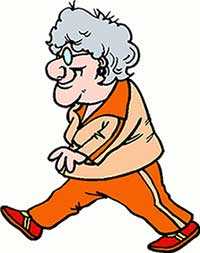 Physical fitness training is catching on with senior citizens, matching the evolution from adolescent "bodybuilding" into stretching and rebalancing the shoulder and pelvis platforms that give most people, most of their physical limitations.
Physical fitness training is catching on with senior citizens, matching the evolution from adolescent "bodybuilding" into stretching and rebalancing the shoulder and pelvis platforms that give most people, most of their physical limitations.
Canaris and Lahousen
 Comparatively few people are aware that the top command layers of the German Intelligence Service (Abwehr) were outraged by Hitler's behavior, and worked actively to undermine the Nazi effort.
Comparatively few people are aware that the top command layers of the German Intelligence Service (Abwehr) were outraged by Hitler's behavior, and worked actively to undermine the Nazi effort.
Children's Scholarship Fund (1)
 The Right Angle Club has decided to make donations to the Children's Scholarship Fund of Philadelphia..
The Right Angle Club has decided to make donations to the Children's Scholarship Fund of Philadelphia..
Line Dividing East from West Jersey
 Although England had owned New Jersey for 17 years, it was unsettled until purchased by Quakers. By 1684 ownership was totally in the hands of two Proprietorships, or corporations, of Quakers. The boundary separating East from West Jersey was a line of 150 boulders from Beach Haven to Trenton. Every land title in the state is based on this survey.
Although England had owned New Jersey for 17 years, it was unsettled until purchased by Quakers. By 1684 ownership was totally in the hands of two Proprietorships, or corporations, of Quakers. The boundary separating East from West Jersey was a line of 150 boulders from Beach Haven to Trenton. Every land title in the state is based on this survey.
George Washington's Cherry Tree, Revisited
 Everybody knows the story of Washington chopping the cherry tree is bunk. But debunking drowns out a greater truth.
Everybody knows the story of Washington chopping the cherry tree is bunk. But debunking drowns out a greater truth.
Only Three Things Wrong With American Healthcare
 What needs to be fixed in American healthcare can be very simply stated as three fundamental problems.
...
What needs to be fixed in American healthcare can be very simply stated as three fundamental problems.
...
Re-Doing Dilworth Plaza
 Plans are afoot to rearrange the whole focus of center-city Philadelphia, by merging the transportation network around City Hall, and changing the walking patterns. Dilworth Plaza is in the center of it all.
Plans are afoot to rearrange the whole focus of center-city Philadelphia, by merging the transportation network around City Hall, and changing the walking patterns. Dilworth Plaza is in the center of it all.
Harry C. Bishop 1921-2009
The Right Angle Club of Philadelphia mourns the loss of a valued member.
Fred Etherington
 The Right Angle Club of Philadelphia honors Fred Etherington, a past president and member of the club for nearly sixty years.
The Right Angle Club of Philadelphia honors Fred Etherington, a past president and member of the club for nearly sixty years.
Printed Books v. Websites
Since this booklet is provided in both printed book form, and online website form, the reader has a chance to compare the two media. Each has its merits.
